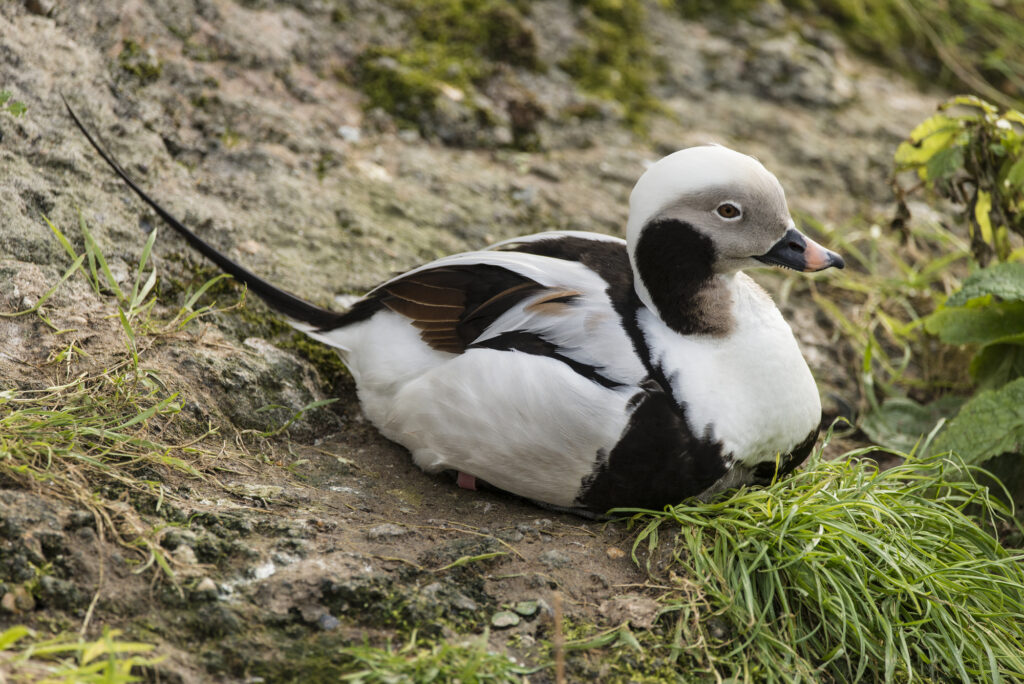The Gem State’s bird population is flourishing. In Idaho’s state parks, national parks, national forests, wetlands, marshes, rivers, lakes, and ponds, you’ll find countless birds of all kinds – songbirds, blackbirds, birds of prey, ducks, geese, and so many more.
The state boasts a gorgeous national bird, the delicate and vibrant Mountain Bluebird.
The waters and wetlands of Idaho are home to many different kinds of ducks. If you find yourself fishing, canoeing, swimming, or hiking along the water’s edge in Idaho, you’re likely to encounter a variety of interesting examples.
There are 27 different kinds of ducks that live in Idaho, some for the summer, some for the winter, some during migration, and some year-round.
Plenty of birders know that identifying ducks is a rewarding pastime.
To learn the differences between species of duck, you’ll need to look at things like their silhouette, coloring and patterns, habitat, specific location in the state, unique sounds, and unusual behaviors.
That’s why we’ve put together a list of 27 of the fascinating species of ducks you may see in Idaho
Two Kinds of Ducks: Dabbling and Diving Ducks
Ducks fit into two categories: dabbling or diving.
Dabbling ducks, which are also called puddle ducks, dip their head under the water and stretch their necks to pull food from the bottom of the water. When they are foraging under the water, their little tails stick up above the surface.
Diving ducks, which are also called sea ducks, dive under the water, submerging themselves completely and re-surfacing about a minute later.
You can’t tell a diving duck from a dabbling duck when they are on land or floating on the water, but one of your first clues to identifying a duck is to watch it eat!
Because of this, we’ve identified each of the following ducks as either a dabbler or a diver.
Now let’s get started with the 27 ducks you can see in Idaho!
American Black Duck (Dabbling Duck)
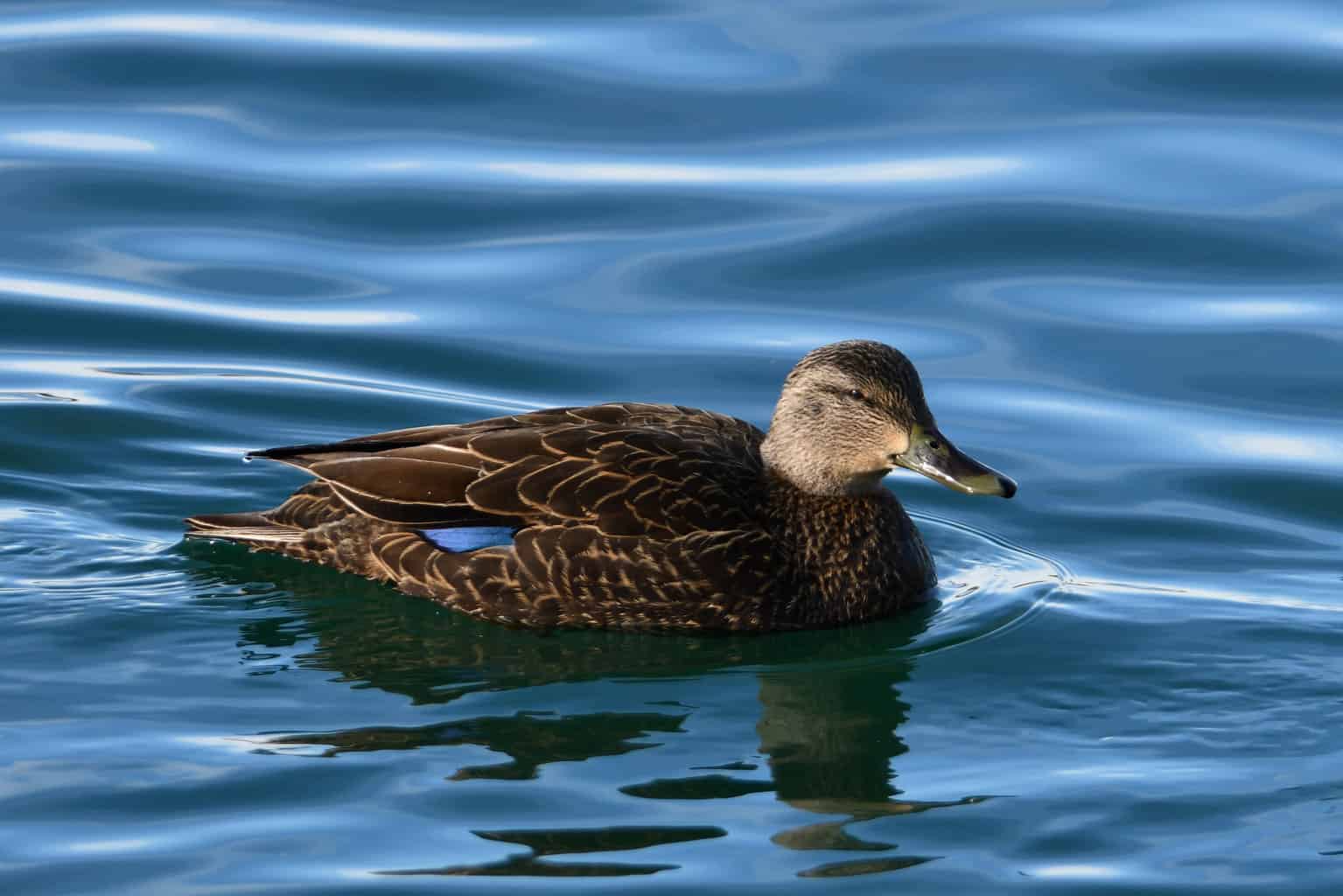
- Scientific Name: Anas rubripes
- Length: 21.3-23.2 inches
- Weight: 25.4-57.9 ounces
- Wingspan: 34.6-37.4 inches
American Black Ducks are very dark brown and white – not actually black. They have pale heads and yellowish-green bills.
The only significant difference between the male and female is that the female is slightly lighter in coloring. She also has a greener bill, whereas his is yellowish.
The underwings of both sexes are bright white, and all adult American Black Ducks have a purple-blue speculum (The speculum is the name for the color bar on a bird’s secondary feathers).
Even though American Black Ducks have been observed in Idaho, they are rare within the state, as they are almost exclusively found in the eastern half of North America.
Most recently, multiple American Black Ducks were spotted in Lewiston in October 2020. Before that, the most recent sighting was in 2012.
American Wigeon (Diving Duck)

- Scientific Name: Mareca americana
- Length: Up to 14 inches
- Weight: About 2.25 pounds
- Wingspan: 34 inches
American Wigeons have been identified in almost every county in Idaho.
These ducks are small and compact, and they migrate south for the winter and return north for the summer breeding season.
The male has an iridescent green band around the back of his head, starting at his eyes. He also has a thick white crown on his head.
Females are brown-bodied with gray heads. Both males and females have a blue-gray bill with a black tip at the end.
American Wigeons are perhaps best known for their cunning thievery. They follow the migratory paths of other ducks and steal their food right from their bills!
Smart little creatures, aren’t they?
Barrow’s Goldeneye (Diving Duck)
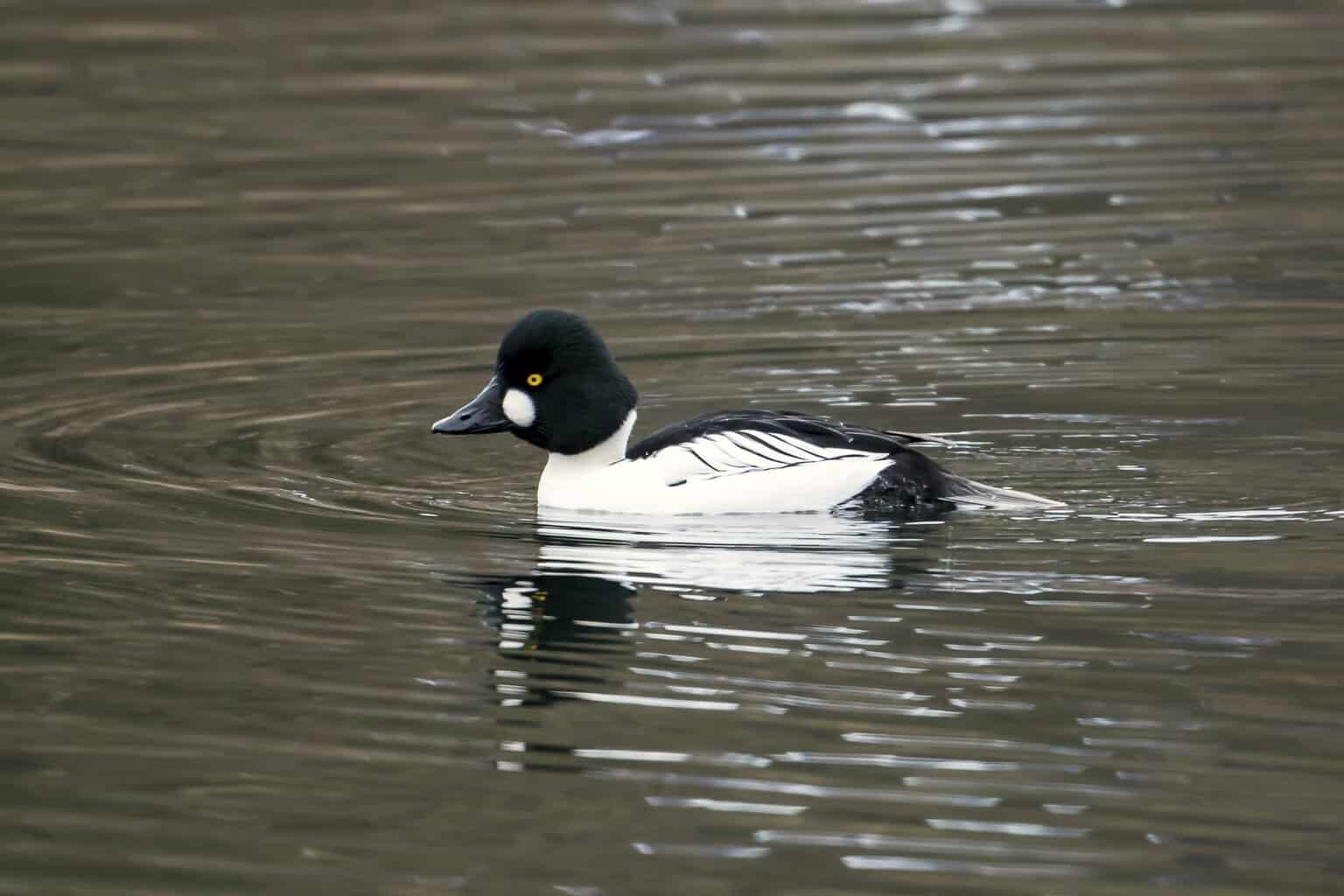
- Length: 16.9-19.1 inches
- Weight: 37.9-46.6 ounces
- Wingspan: 27.6-28.7 inches
Barrow’s Goldeneyes have a small range. Unlike ducks that spread out through North America, you’ll only find Barrow’s Goldeneyes in a few places: northwestern North America and a very small part of eastern Canada and Iceland.
They are year-round residents in much of Idaho who are often found alongside groups of Common Goldeneyes.
Adult males have a bright white chest and a black and white back and a dark purple-ish head. They have a white mark in the shape of a crescent between the eye and the bill. A series of white dots run along the male’s back.
Females have copper-brown heads, yellow bills, and grayish bodies.
In Iceland, these ducks are especially plentiful around Lake Myvatn. People in this region build nest boxes for Barrow’s Goldeneyes, and there is great pride in having one of these ducks choose your nest box and call your home their home.
Unfortunately, this practice doesn’t seem to happen outside of Iceland!
Black Scoter (Diving Duck)
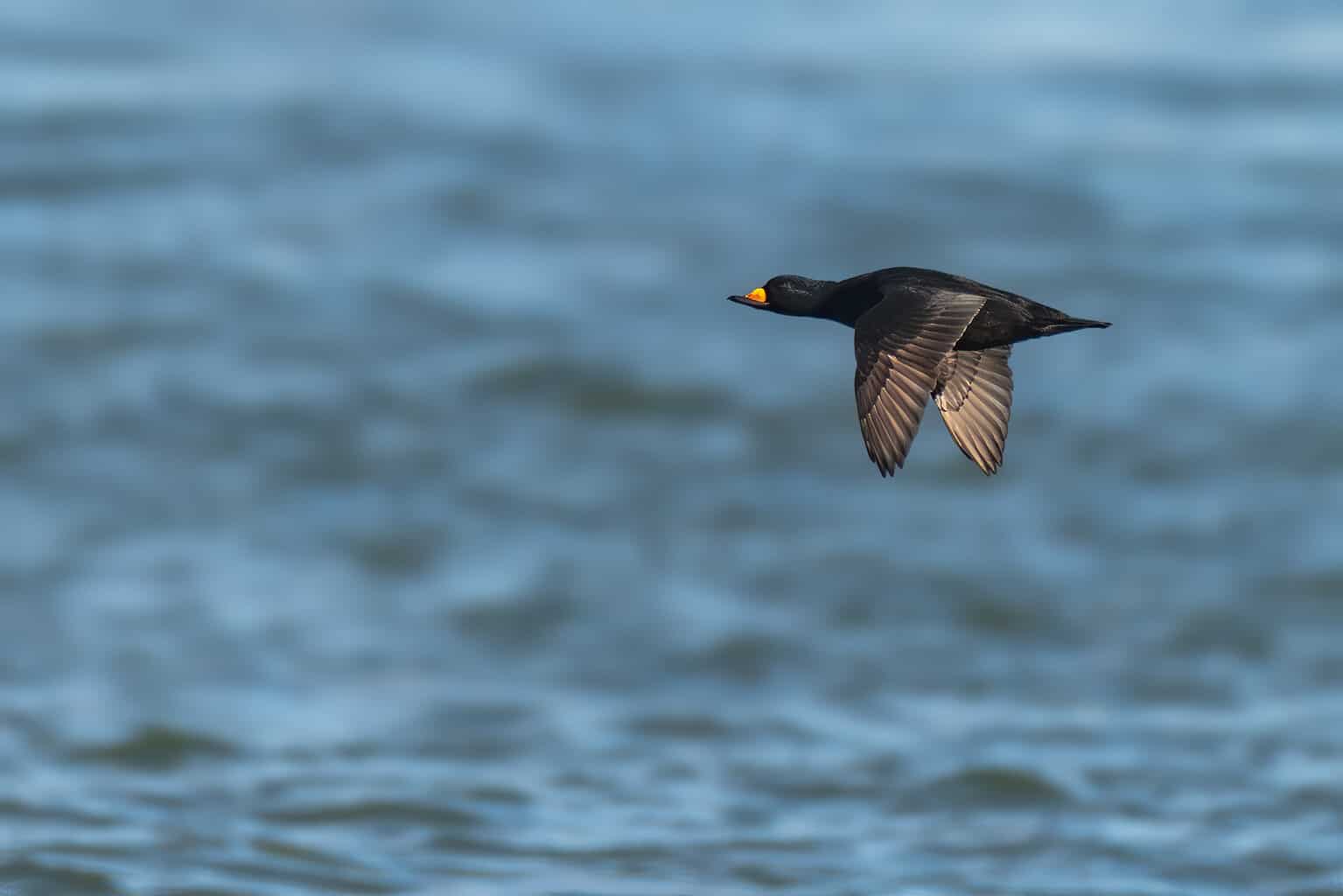
- Length: 16.9-19.3 inches
- Weight: 30.4-38.8 ounces
- Wingspan: 27.6-28.4 inches
The Black Scoter’s appearance is different from every other duck on this list. Adult males are all black – not dark green or dark purple, but truly black. Males also have a thick orange knob-shaped bump on the base of their bill.
Females’ bodies are dark and light brown, and the top of their heads are dark brown. The female Black Scoter’s bill is all black.
The Black Scoter’s habitat changes season by season. They spend the winter in ocean waters, but they stop on rivers and lakes as they migrate. Their summer breeding territory is on lakes in the boreal forest.
Black Scoter ducks are not regular residents of Idaho, but there have been verified observations in five counties: Bannock, Bonneville, Fremont, Latah, and Power.
Blue Winged Teal (Dabbling Duck)
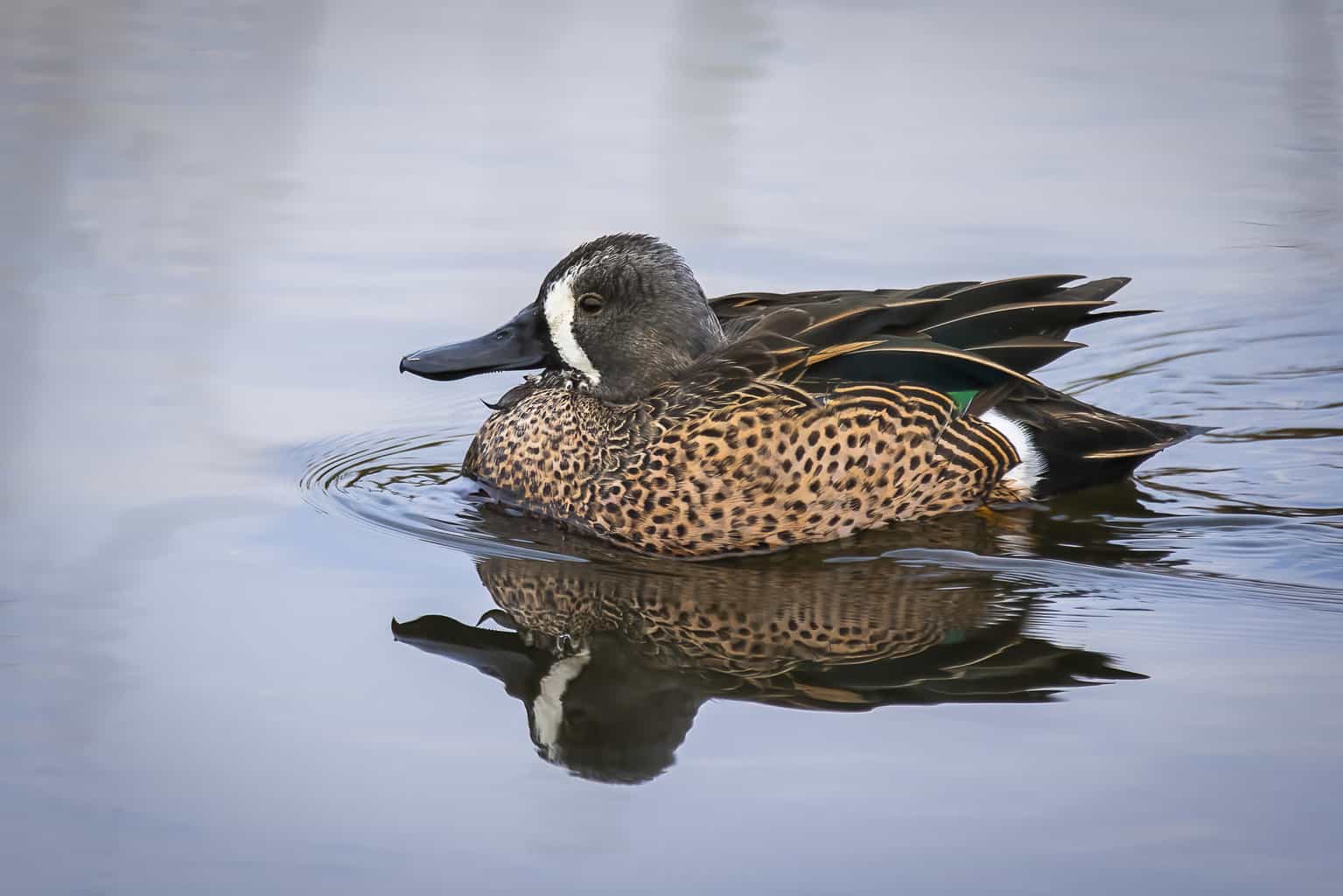
- Scientific Name: Anas discors
- Length: 16 inches
- Weight: 13 ounces
- Wingspan: 23 inches
You may see the Blue-Winged Teal Duck in Idaho during its breeding season, from March to November. They are scattered throughout the state and prefer grassy wetlands like ponds and marshes.
The Blue-Winged Teal Duck is a late migrant.
Males are mostly brown during the breeding season when they are present in Idaho. The male’s cream-colored breast is covered with brown speckles. he has a blueish-gray head, a white patch near the tail, and a thick white stripe on his face.
At the end of the breeding season, he starts looking more like the female, with plain brown feathers and a blue wing patch.
Interestingly, Blue-Winged teal Ducks are actually the second most populous duck in North America. They are only second to Mallards. Their huge breeding range covers most of the US and Canada.
Bufflehead (Diving Duck)
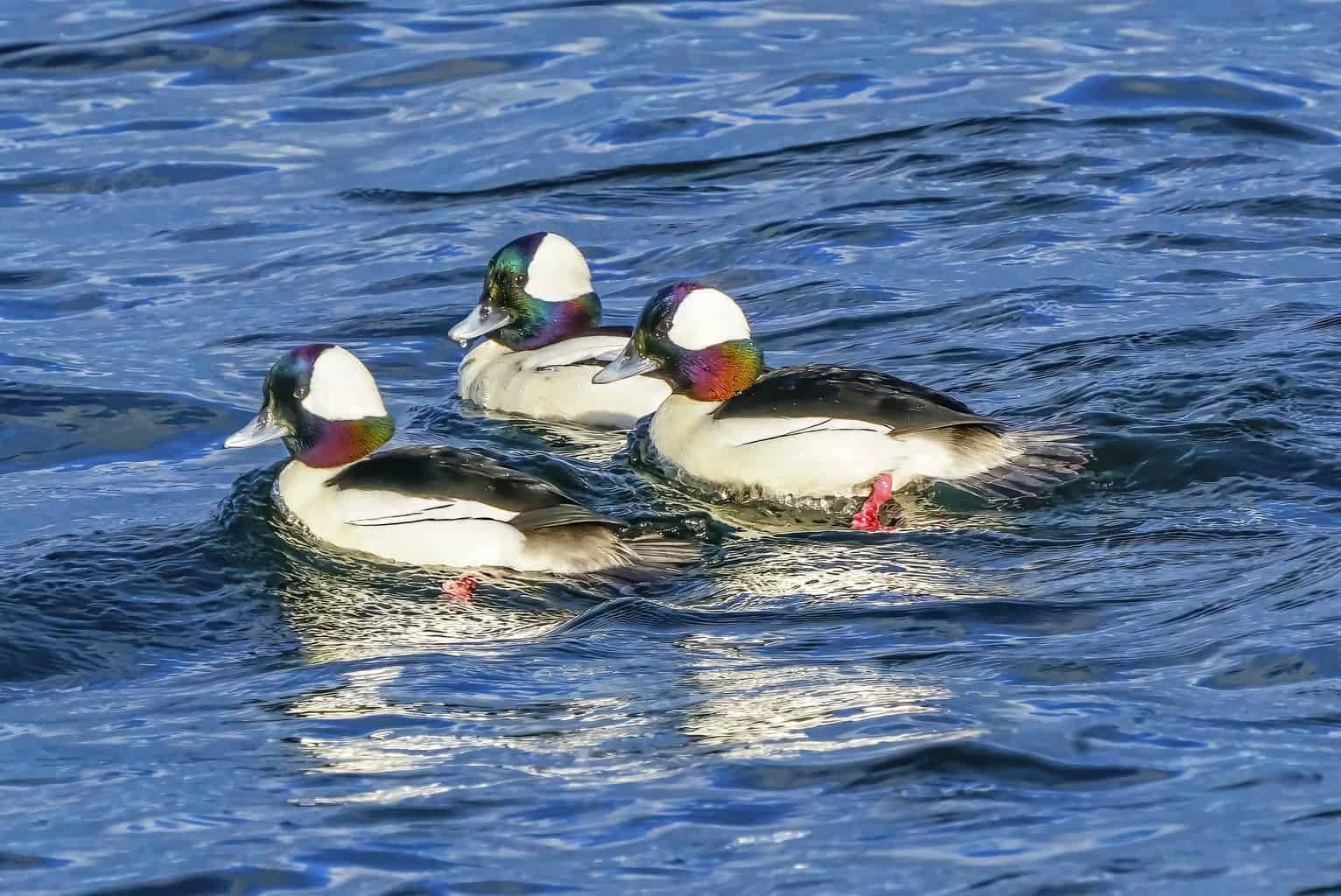
- Scientific Name: Bucephala albeola
- Length: 13-16 inches
- Weight: 11-16 ounces
- Wingspan: 22 inches
The Bufflehead earned its name from the fact that it has a big, fluffy head. To some people, this is reminiscent of a buffalo head. Hence, “Bufflehead!”
The male’s body is bright white, and he has a black back and an iridescent head that is green or purple, depending on the light. He has a large, white, fan-shaped patch on his head.
Females and juveniles have gray-brown bodies and a small oval check patch.
Buffleheads live in Idaho year-round! In the Idaho panhandle, they are both breeding and non-breeding residents. In the south of the state, they are only present in the winter.
As cavity dwellers, Buffleheads like to take over the abandoned nests of other birds, especially Northern Flickers. They can fit into these smaller cavities because they are the smallest diving ducks in North America.
Canvasback (Diving Duck)
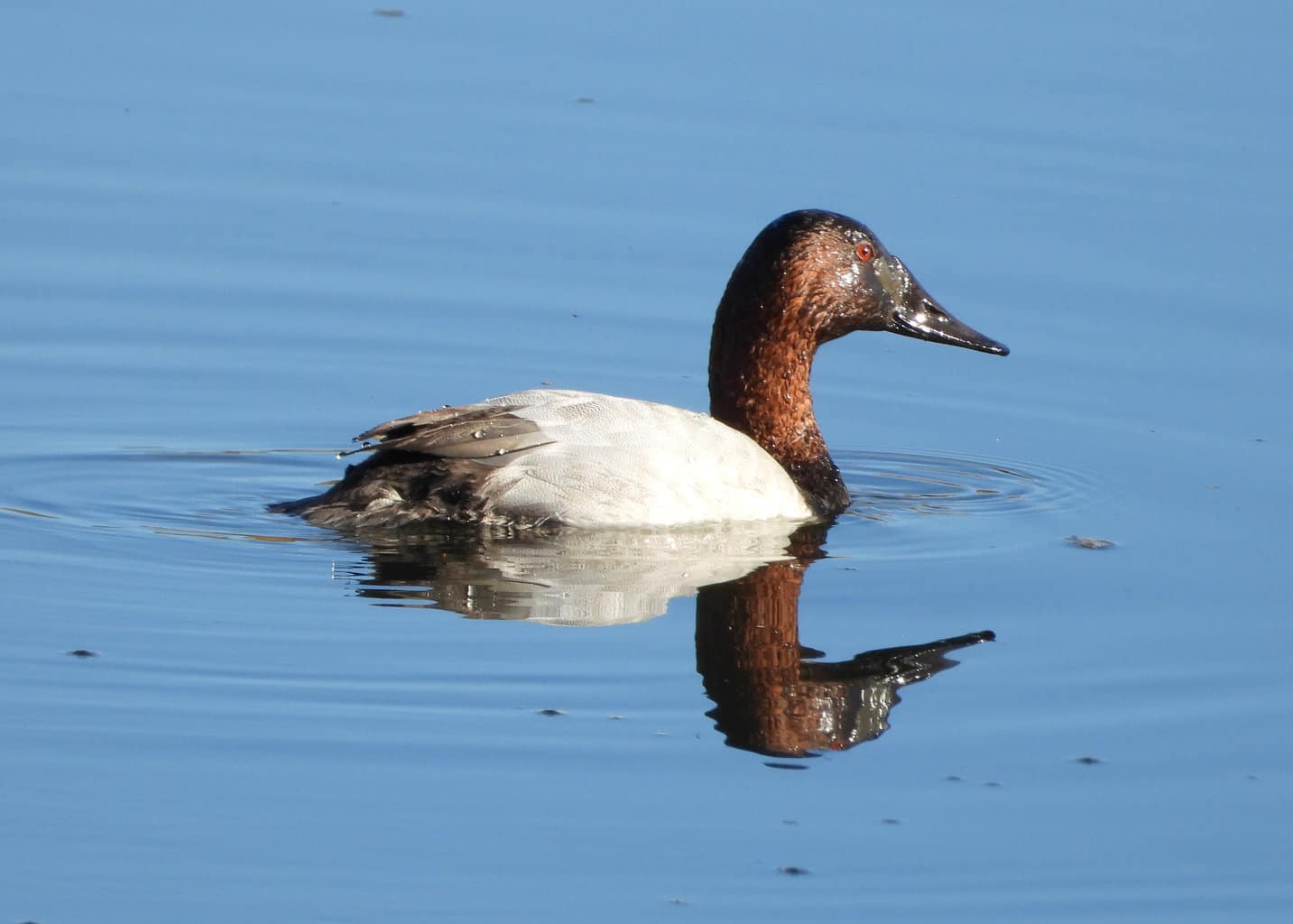
- Scientific Name: Aythya valisineria
- Length: 13-16 inches
- Weight: Up to 2.5 pounds
- Wingspan: Up to 3 feet
Canvasbacks are big ducks with thick necks and big heads. They have a nice, long bill to match!
Their coloration pattern is about the same, regardless of sex, but males are black, white, and brown, whereas females are paler. Males have red eyes, and females have black eyes.
The Canvasback duck has a thick neck, big head, and long bill. Males are black, white, and brown. Females have a similar tri-colored pattern, but they are just a bit paler.
For the most part, Canvasbacks are only in Idaho during their migration window. When they migrate, they stick together in groups of about 10-50 individuals. This is far smaller than ducks species that migrate with thousands of other ducks!
However, some Canvasbacks will settle across the south of Idaho for the breeding season. Females migrate out of the breeding season first.
Here’s a cool fact: Canvasbacks can fly up to 72 miles per hour, which is much faster than the average duck’s speed of about 40 miles per hour.
Cinnamon Teal (Dabbling Duck)
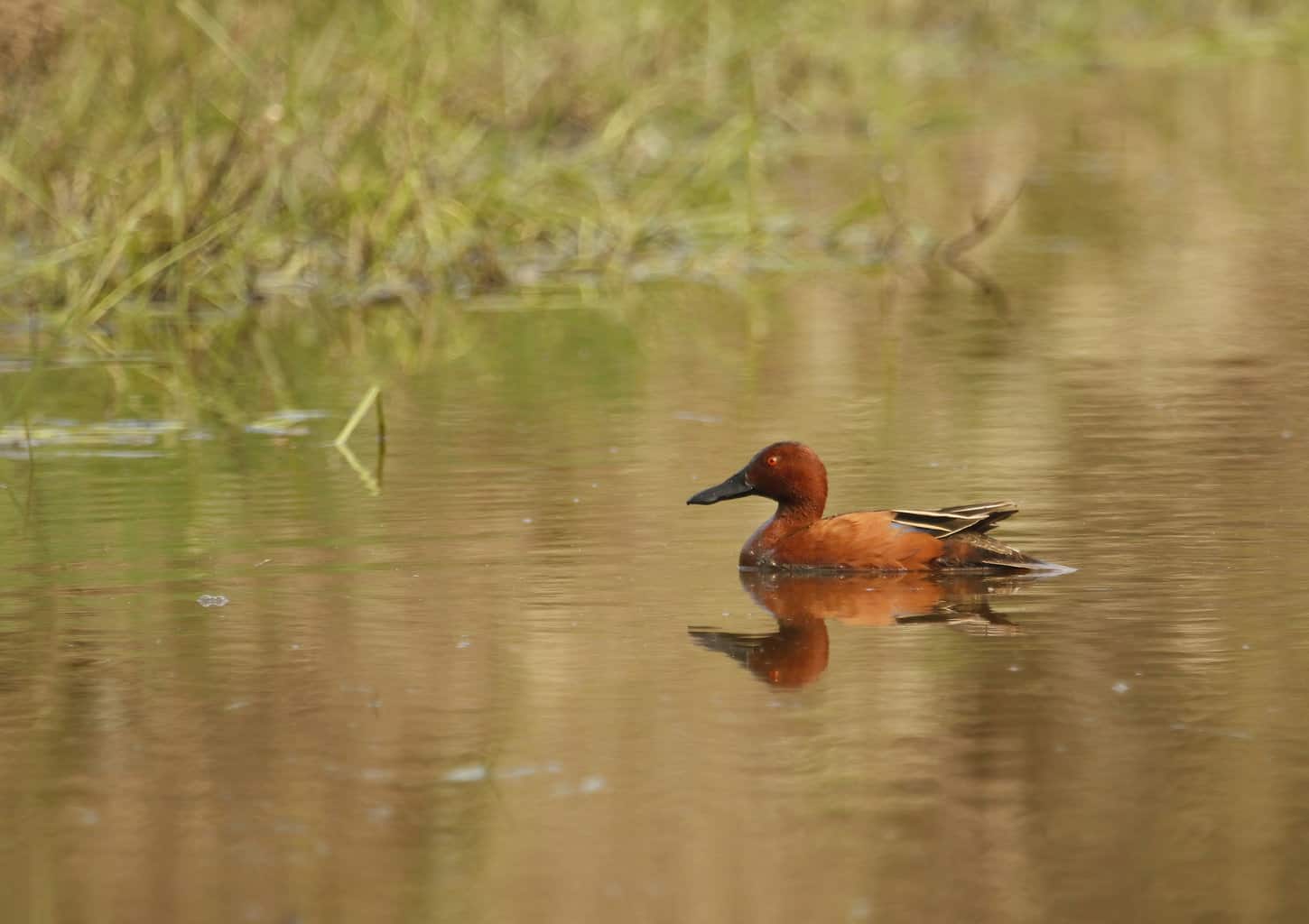
- Scientific Name: Spatula cyanoptera
- Length: 11 inches
- Weight: 12.6-18.2 ounces
- Wingspan: 25 inches
The Cinnamon Teal Duck is only present in Idaho during the summer when they nest in the tall grasses along the water. Females nest in those tall grasses and build extensive tunnel systems underneath the grass to move to and from the water undetected.
During the breeding season, male Cinnamon Teal Ducks are deep, rusty brown on most of their bodies. They have brown and black primary feathers and green secondary feathers.
Females, juveniles, and non-breeding males are lighter brown with dark brown mottling. All adult Cinnamon Teal Ducks have a sky-blue patch of feathers on their shoulders.
Common Goldeneye (Diving Duck)
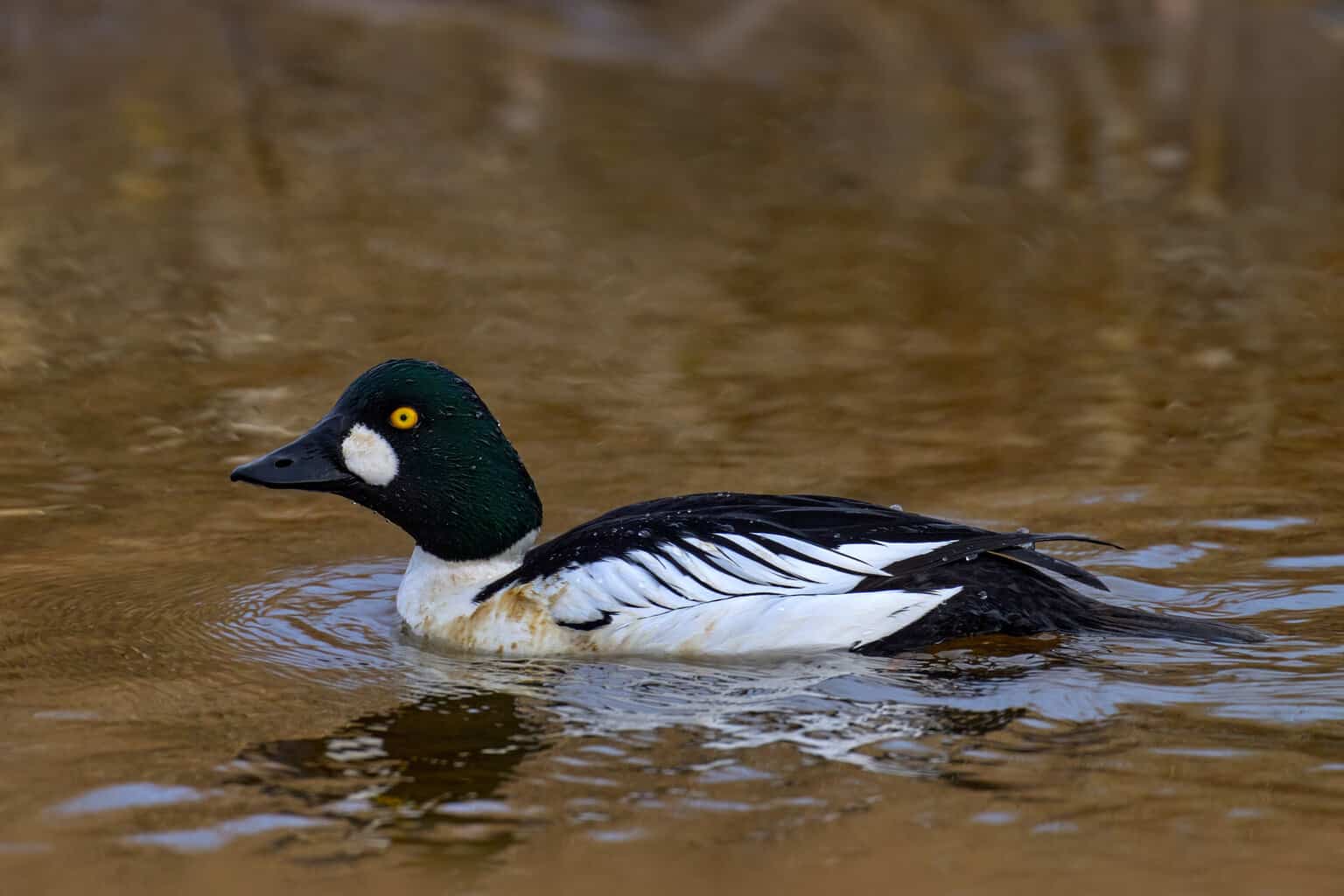
- Scientific Name: Bucephala clangula
- Length: 16-20 inches
- Weight: Approximately 1.8 pounds
- Wingspan: 30.3-32.7 inches
Common Goldeneyes get their name from their bright yellow-gold eyes.
Males and females look quite different from one another during the summer. Breeding males have white and dark green feathers, which almost look black. In fact, less experienced observers will often refer to them as black and white ducks.
The male also has a small white patch on his cheek and another on his wings.
Females have gray bodies, brown heads, and no cheek patches. In winter, males look pretty similar to females.
Common Goldeneyes breed throughout most of Canada and then move into the US for the winter. In Idaho, there are a few areas where they are present year-round (mostly the northern panhandle and the eastern corner), but they are generally in winter.
Look for them on large lakes and rivers.
Common Merganser (Diving Duck)
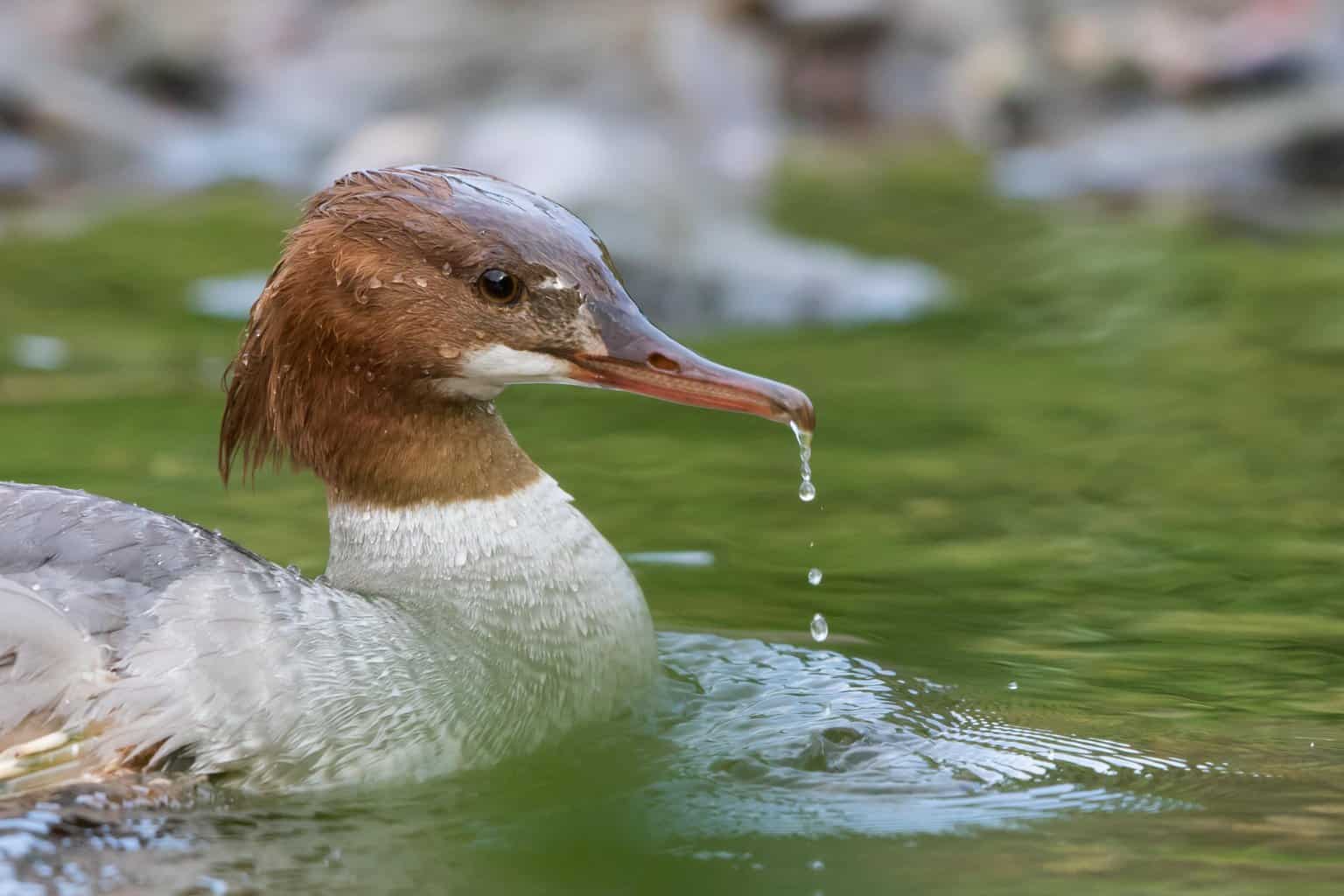
- Scientific name: Mergus merganser
- Length: 21.3-27.9 inches
- Weight: 31.8-76.2 ounces
- Wingspan: 33.9 inches
Common Mergansers are year-round residents of Idaho. They live along lakes and rivers, especially those that are popular with other ducks and birds. They like to follow other birds around because they can steal their food!
Mergansers will steal fish away from other ducks, gulls, and even bald eagles!
The breeding male Common Merganser has a shiny green head, white body, black back, and bright red bill with a black tip. The female’s head is cinnamon-colored, and her body is gray. She has a cool-looking jagged crest, too.
They prefer freshwater, including wooded lakes and rivers. They tend to avoid dense grasses and muddy rivers.
Eurasian Wigeon (Dabbling Duck)
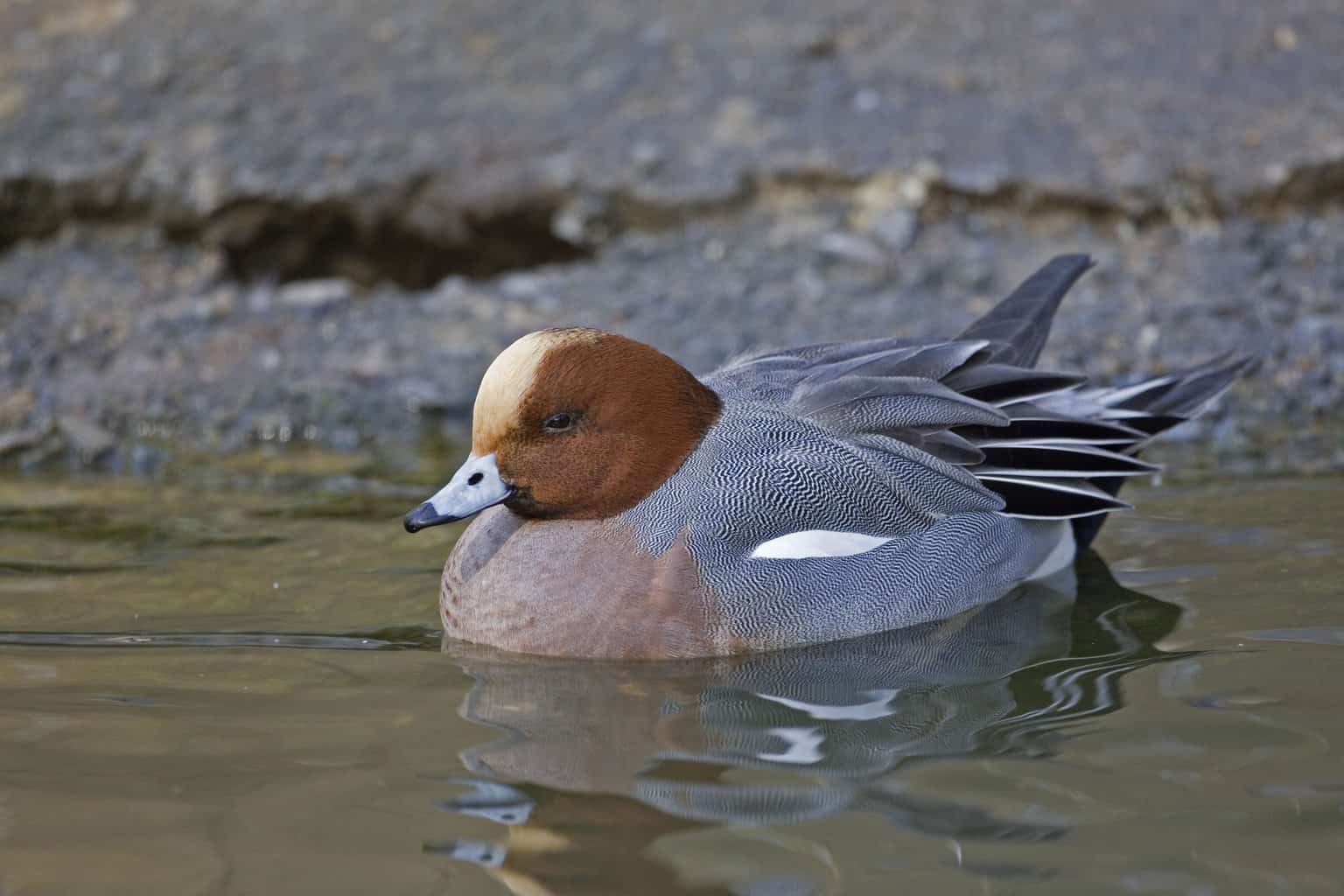
- Scientific name: Mareca penelope
- Length: 17-20 inches
- Weight: 1.102-2.366 pounds
- Wingspan: 28-31 inches
Eurasian Wigeons are rare in North America, but there have been several confirmed sightings in Idaho, especially in the southwestern corner of the state along the Snake River.
The male Eurasian Wigeon has a gray body and a rufous head topped with a creamy white forecrown. Females are rich dark brown and light brown with speckled heads.
The habitat of the Eurasian Wigeon is similar to the American Wigeon; they often spend time in the same waters and will even interbreed.
During the breeding season, they live along ponds, marshes, and lakes. In winter, they prefer freshwater, including marshes and lakes. They will also inhabit saltwater lagoons and bays.
Gadwall (Dabbling Duck)
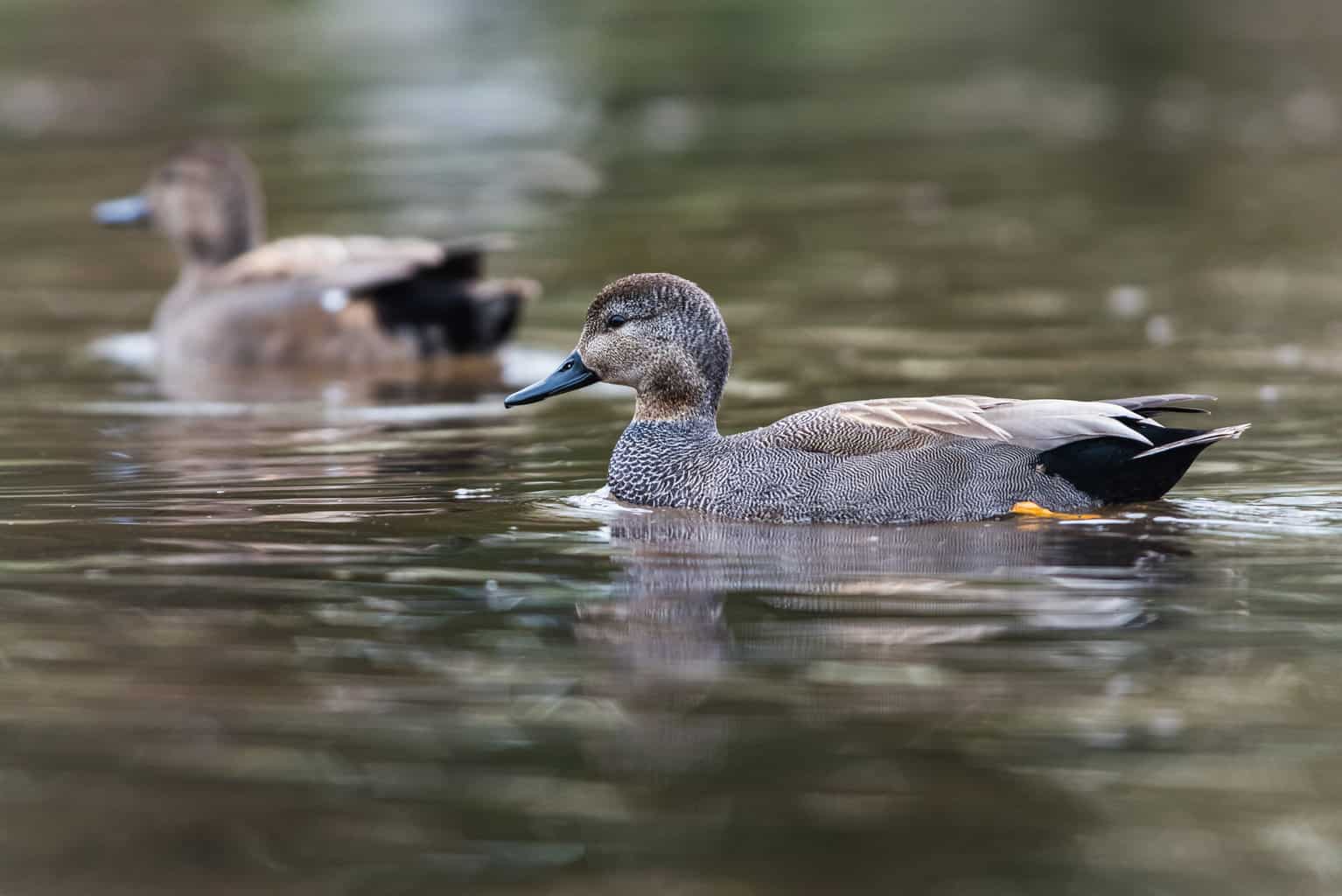
- Scientific Name: Mareca strepera
- Length: 18.1-22.4 inches
- Weight: 17.6-44.1 ounces
- Wingspan: 33.1 inches
Like the American Wigeon and Common Merganser, the Gadwall also steals food from other ducks. They are dabblers, not divers, but they wait for divers to re-surface – and then snatch their food right out of their bills!
Male and female Gadwall are muted, especially when compared to far more colorful ducks you can find in Idaho. They have squarish heads with thin necks and bills. When sitting on the water, you should be able to see a white wing patch on both males and females.
Males are gray and green, whereas females are brown and off-white.
They live in Idaho year-round, usually in small lakes with plenty of grasses along the water’s edge. Look for them in prairie marshes, such as the ones on the Camas Prairie.
Greater Scaup (Diving Duck)
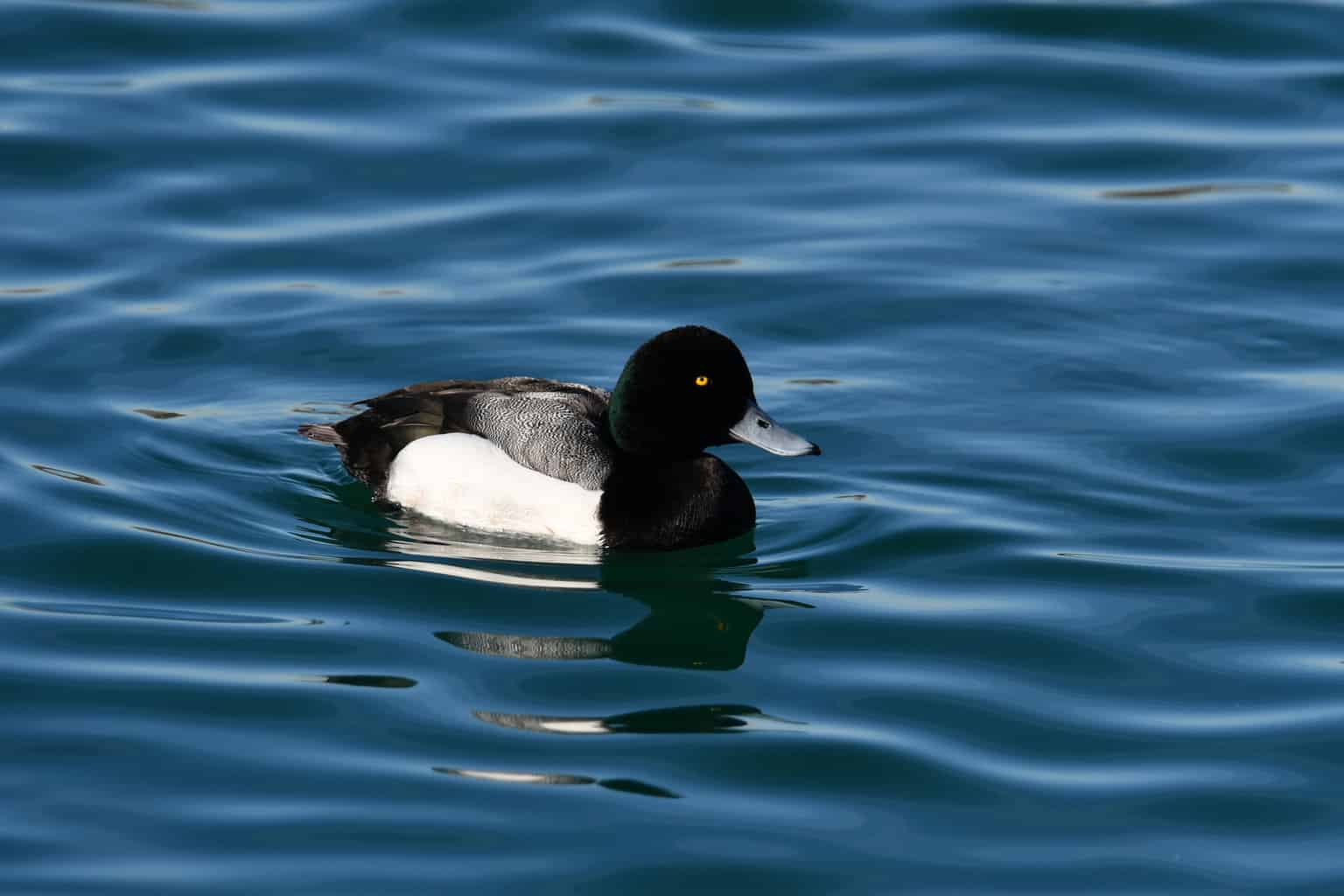
- Scientific Name: Aythya marila
- Length: 15-22 inches
- Weight: 1.5-2.9 pounds
- Wingspan: 28-33 inches
Scaup are called Bluebills, thanks to their broad, blue bills. There are two kinds of Scaup that are native to North America: Greater and Lesser.
Male Greater Scaup have iridescent green heads, white bodies, and barred brown-and-white backs during the breeding season. Females have dark brown heads and light brown bodies.
During the winter, male Greater Scaup look like a sort of hybrid of a female and a breeding male, with a brown and gray body and a blackish head.
Greater Scaup have been observed many times in Idaho, but they are not plentiful. Most frequently, they are spotted along the Snake River. You’re more likely to see them in the winter than in the summer.
Green-Winged Teal (Dabbling Duck)
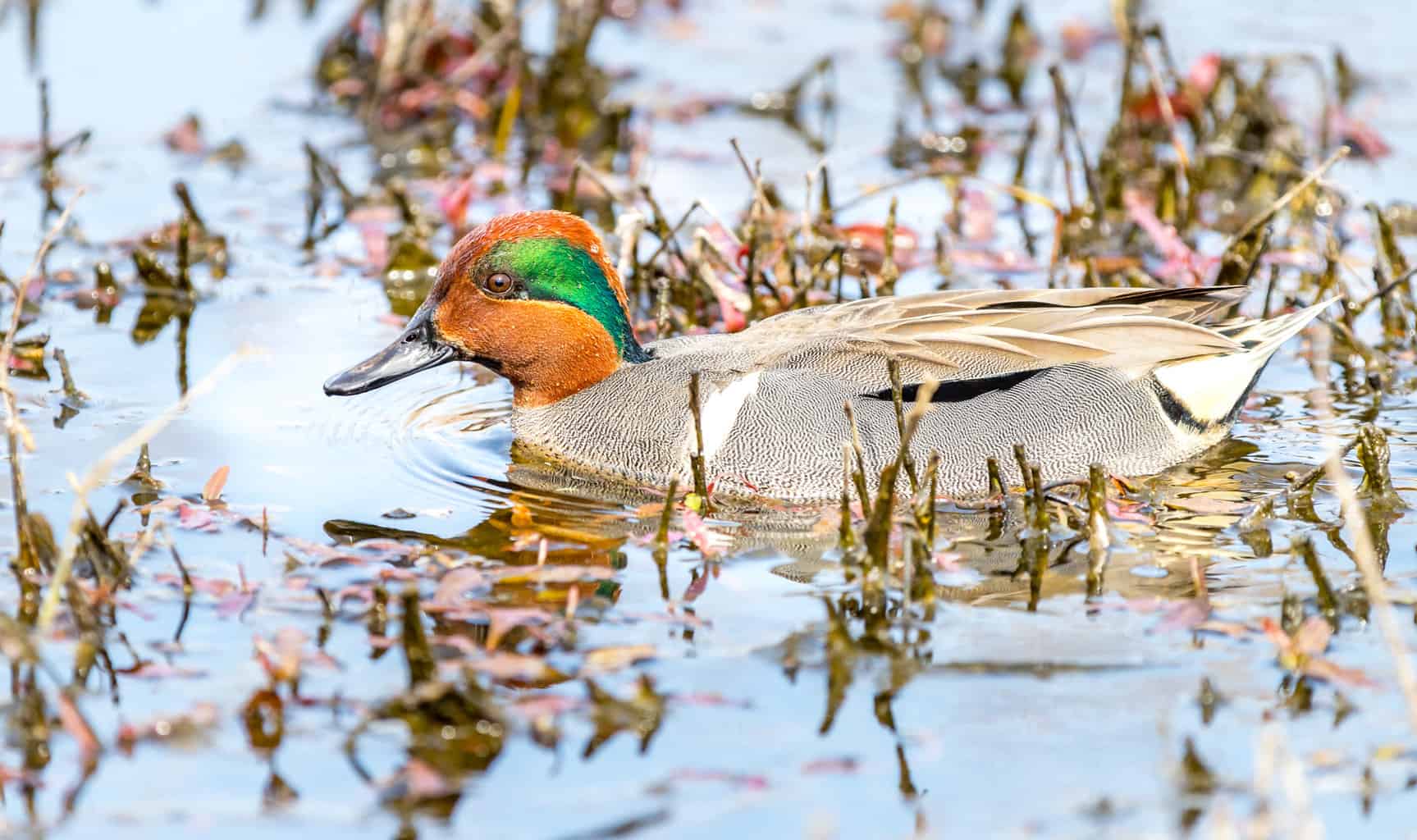
- Scientific Name: Anas carolinensis
- Length: 12.2-15.3 inches
- Weight: 4.9-17.6 ounces
- Wingspan: 20.5-23.2 inches
Male Green-Winged Teal Ducks are marked by a glimmering green stripe that runs from the eyes to the back of their coppery head. Females have light barring in both brown and light brown.
Both males and females have an iridescent green speculum, which can always be seen in flight, but is only occasionally visible when the duck is on the water.
Green-Winged Teal Ducks are the country’s smallest dabbling duck. They live throughout Idaho, especially in the summer.
Harlequin Duck (Diving Duck)
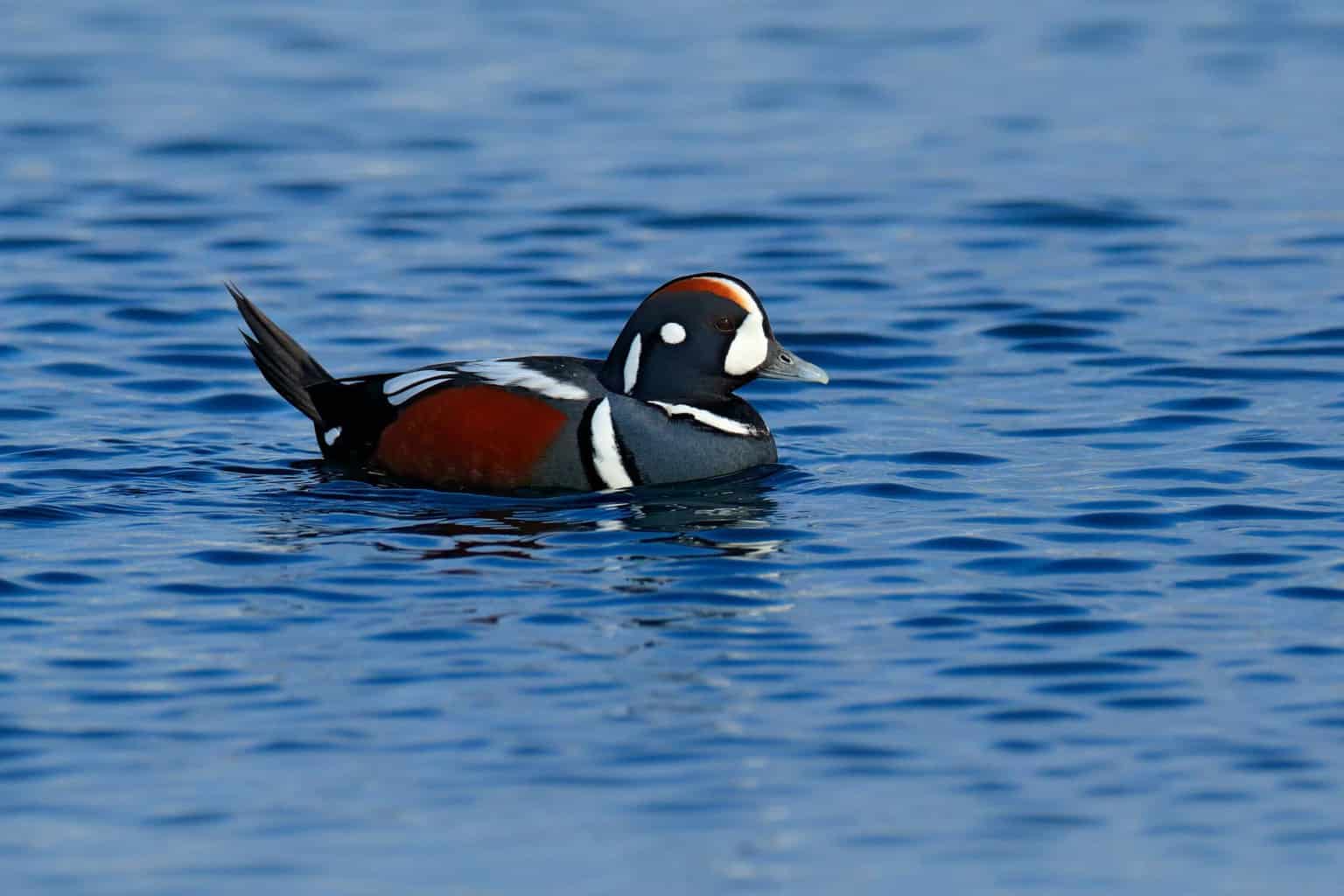
- Scientific Name: Histrionicus histrionicus
- Length: 13.4-18.1 inches
- Weight: 17.3-26.8 ounces
- Wingspan: 22.1-26.0 inches
You’ll only see Harlequin Ducks in northern Idaho, and only in the summertime. Their primary breeding range is along the Pacific Coast, and they tend to move far north during the winter.
Male Harlequins are striking in appearance during the breeding season. He has a very dark blue head with a white crescent in front of his eyes. His slate-blue body is lined with a few thick white stripes, and his sides are chestnut brown.
Females are brown with pale faces and a small white patch on the back of the head.
They live along rough waters, and their bodies pay the price. Researchers have found that Harlequin Ducks often experience broken bones and head trauma, as they are thrown around in the waves and rocks.
Hooded Merganser (Diving Duck)
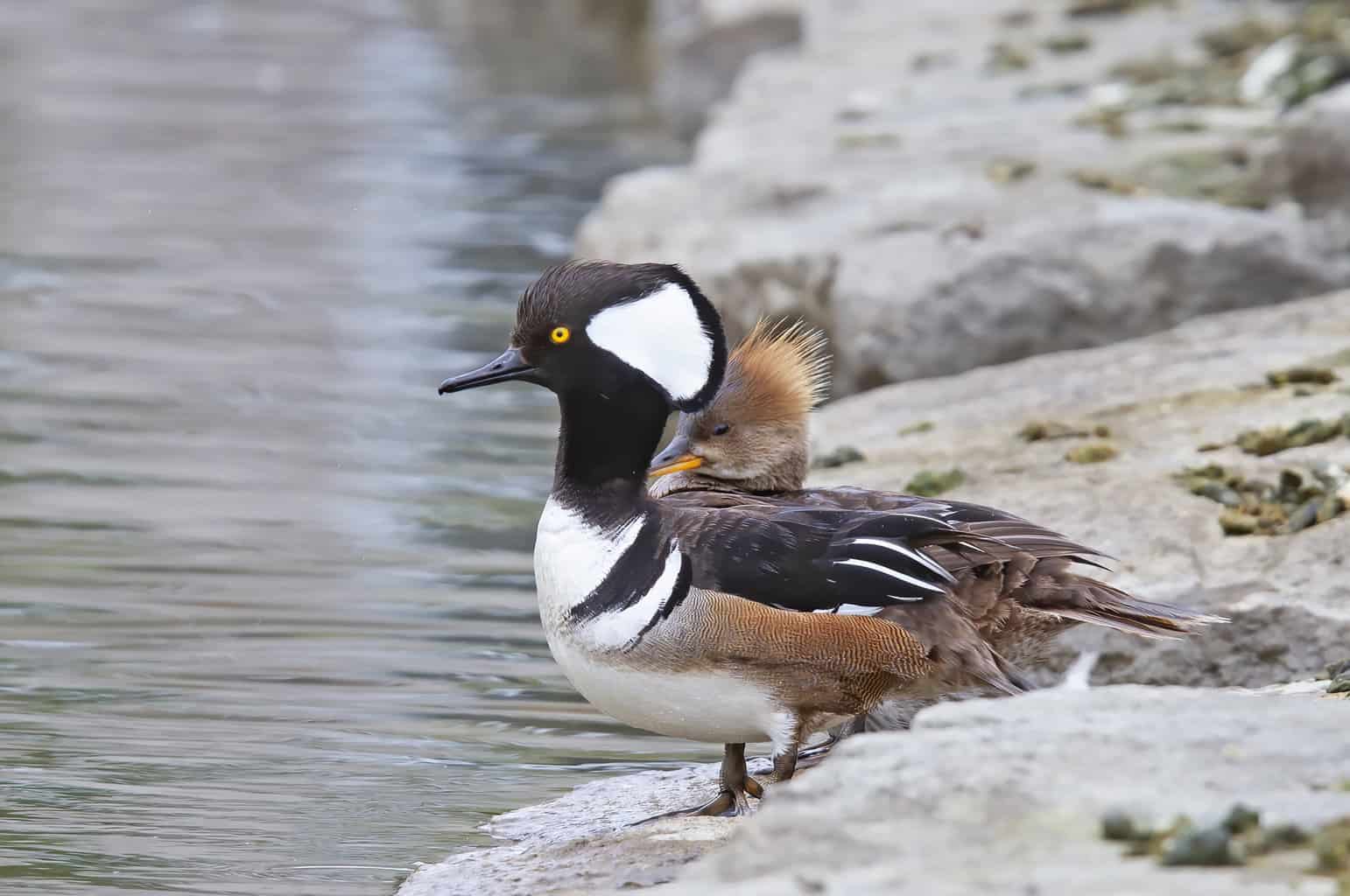
- Scientific Name: Lophodytes cucullatus
- Length: 15.8-19.3 inches
- Weight: 16-31 ounces
- Wingspan: 23.6-25 inches
The Hooded Merganser is probably best known for its unusual vocalizations. It sounds enough like a pickerel frog’s croak that it has earned the nickname “frog-duck.”
Mergansers are also pretty easy to identify by sight, thanks to their ragged crests. The male crest is black and white, whereas the female crest has a reddish-brown color.
Whether or not you will see a Hooded Merganser in Idaho is dependent upon where you are – and when you are there!
They are winter-only inhabitants in the south, spring and fall migratory vagrants in the middle of the state, and both breeding and non-breeding residents in both the north and the far northeast.
They are most frequently spotted along the waters of the Snake River.
Lesser Scaup (Diving Duck)
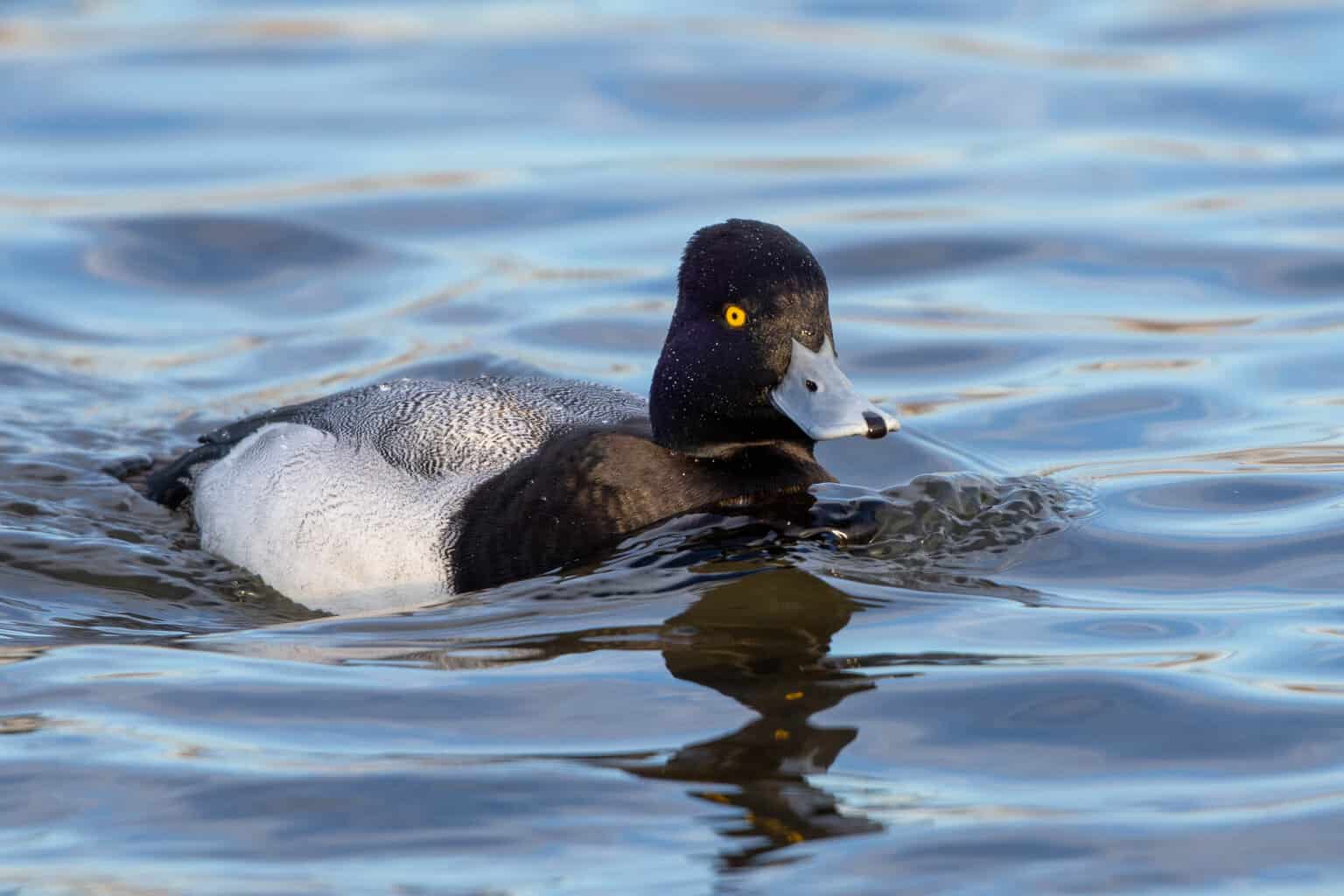
- Scientific Name: Aythya affinis
- Length: 15.3-18.1 inches
- Weight: 16-38.4 ounces
- Wingspan: 26.8-30.7 inches
We’ve already talked about the Greater Scaup – now let’s talk about the Lesser Scaup! With about 4 million Lesser Scaup in North America, they are the most populous diving ducks in the whole continent.
Lesser Scaup are most likely to be found in Idaho during their fall and spring migration period, although some can be found along the Snake River year-round.
Greater and Lesser Scaup may have a lot in common, but the Lesser Scaup’s egg-shaped head is a great way to differentiate between the two.
Males have dark-colored heads. Technically, they’re very dark green or purple, but people usually describe them as black and white. Females have dark brown heads and light brown bodies.
Long-Tailed Duck (Diving Duck)
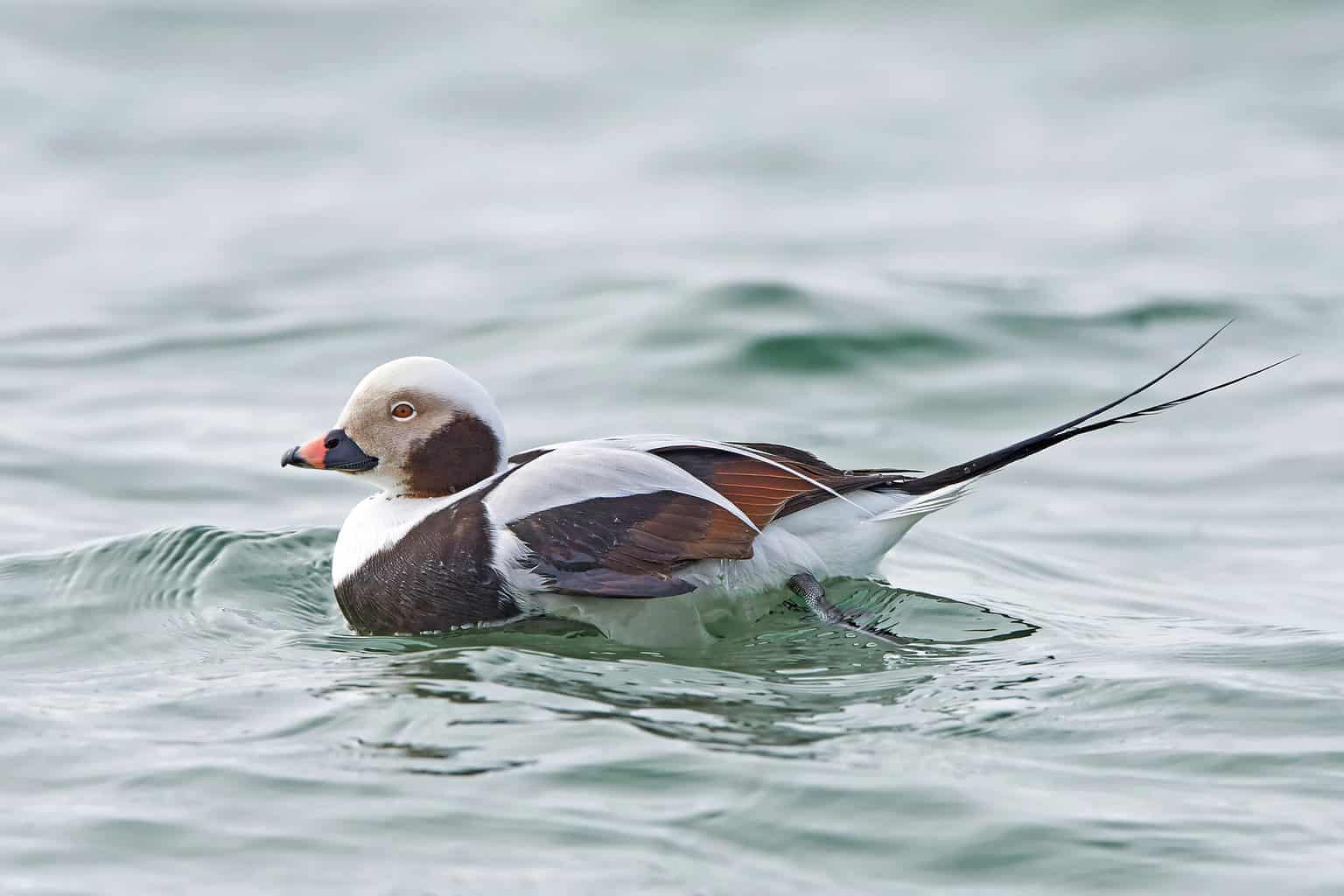
- Scientific name: Clangula hyemalis
- Length: 15.8-18.5 in (40-47 cm)
- Weight: 22.9-38.8 oz (650-1100 g)
- Wingspan: 27.9-28.4 in (71-72 cm)
Long-Tailed Ducks have a fascinating appearance. The non-breeding male is black, white, and brown, with long white plumes covering his body.
He has long, curly black tail feathers and a black bill that is banded in pink. In the summer, his colors practically reverse themselves!
Females are white and brown, and their appearance varies from winter to summer as well.
They spend their summers far north, in the Arctic Circle. They are not common in the US, but they are occasionally spotted in Idaho during the winter.
Mallard (Dabbling Duck)
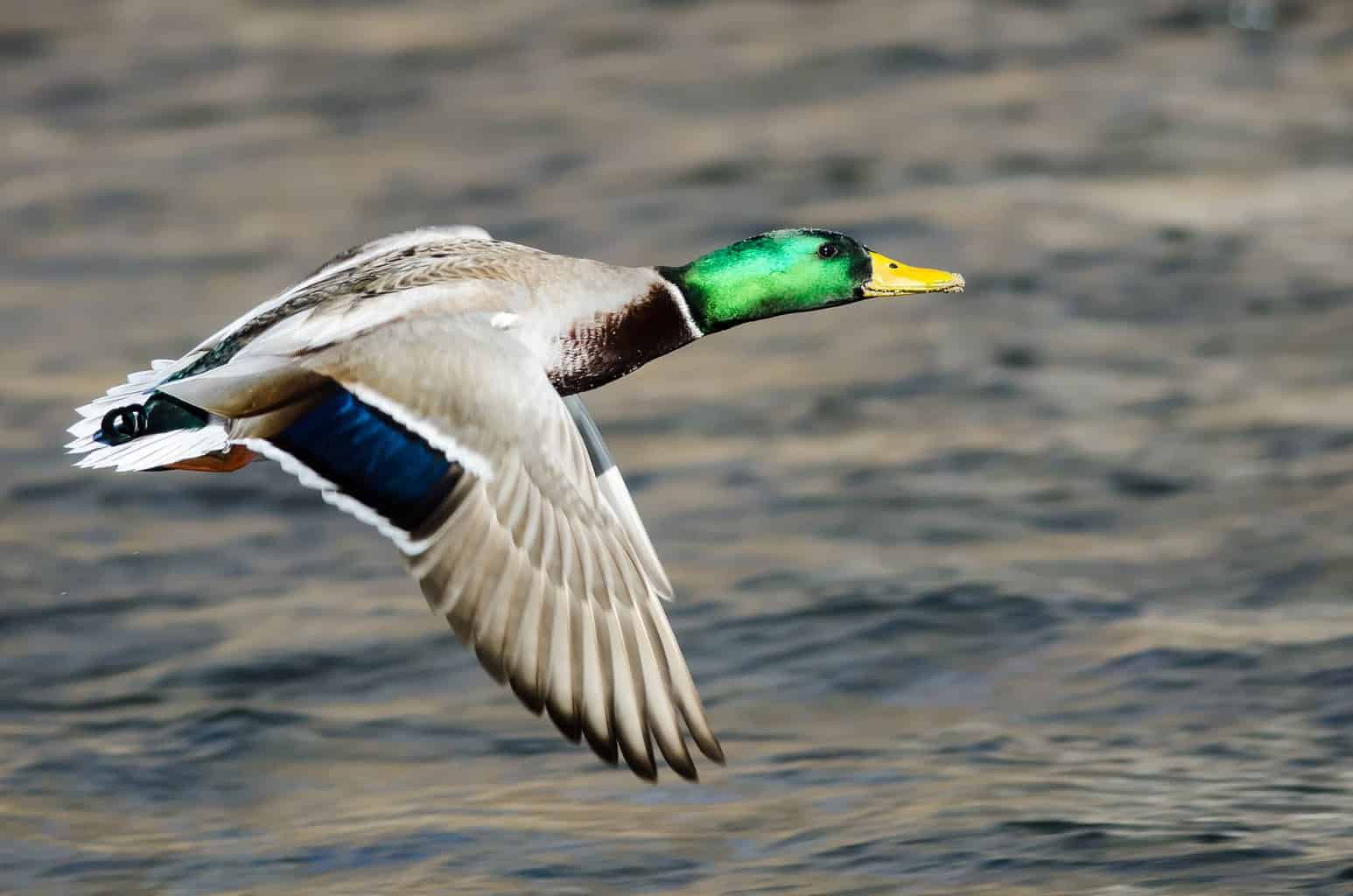
- Scientific Name: Anas platyrhynchos
- Length: 20-26 inches
- Weight: 1.5-3.5 pounds
- Wingspan: 32-39 inches
Few birds are as iconic as the Mallard.
They are found across Europe, Asia, Africa, and North America. The male Mallard has a thin white ring around his neck, as well as a brown breast, a gray body, and a black tail.
During the winter, his coloring fades to light green and brown. Females are dark brown with light brown streaks.
Mallards have proliferated in countless habitats, including wetlands, marshes, floodplains, lakes, and reservoirs. They live across Idaho, in both the breeding and non-breeding seasons.
An interesting fact about Mallards is that they are the common ancestor to almost every domestic breed of duck. This is because they are prone to interbreeding.
Northern Pintail (Dabbling Duck)
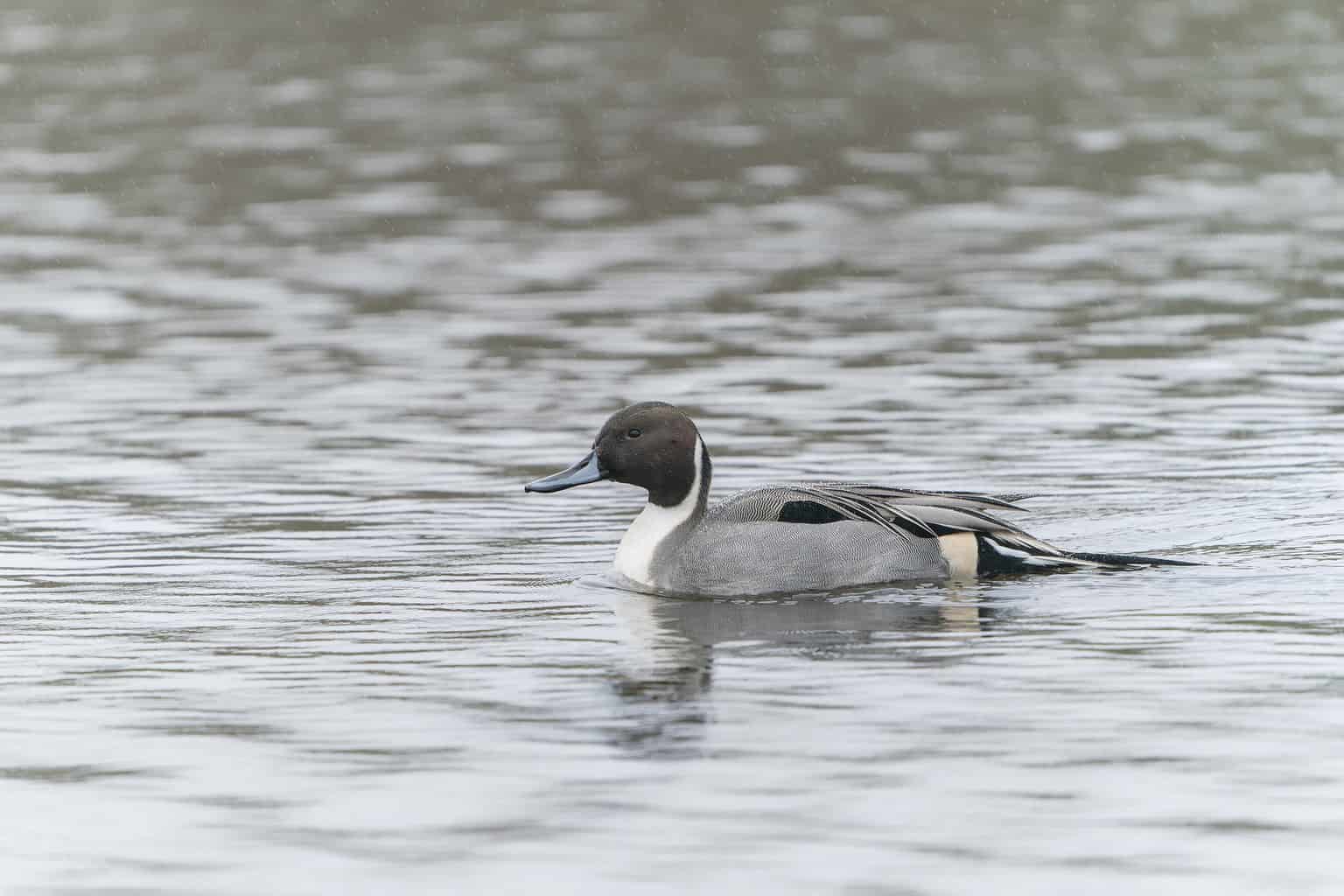
- Scientific Name: Anas acuta
- Length: 20-30 inches
- Weight: 1-3 pounds
- Wingspan: 20-30 inches
The Northern Pintail has a significant range. They breed and nest throughout Canada and the western US states, including Idaho, Montana, South Dakota, and North Dakota.
In the summer, male Northern Pintails have a few long, thin, pointed tail feathers. They lose these feathers for the rest of the year.
All adult Northern Pintails have a colorful speculum; males have an iridescent green speculum, and females have an iridescent brown speculum.
Pintails eat aquatic plants, seeds, and grasses, as well as small water-dwelling animals. They can be found in many of Idaho’s wetlands, including lakes and agricultural ponds.
One of the most impressive things about the Northern Pintail is its migratory distance. They will travel up to 1800 miles during their migration, going to and from northern Canada and southern Mexico.
Northern Shoveler (Dabbling Duck)
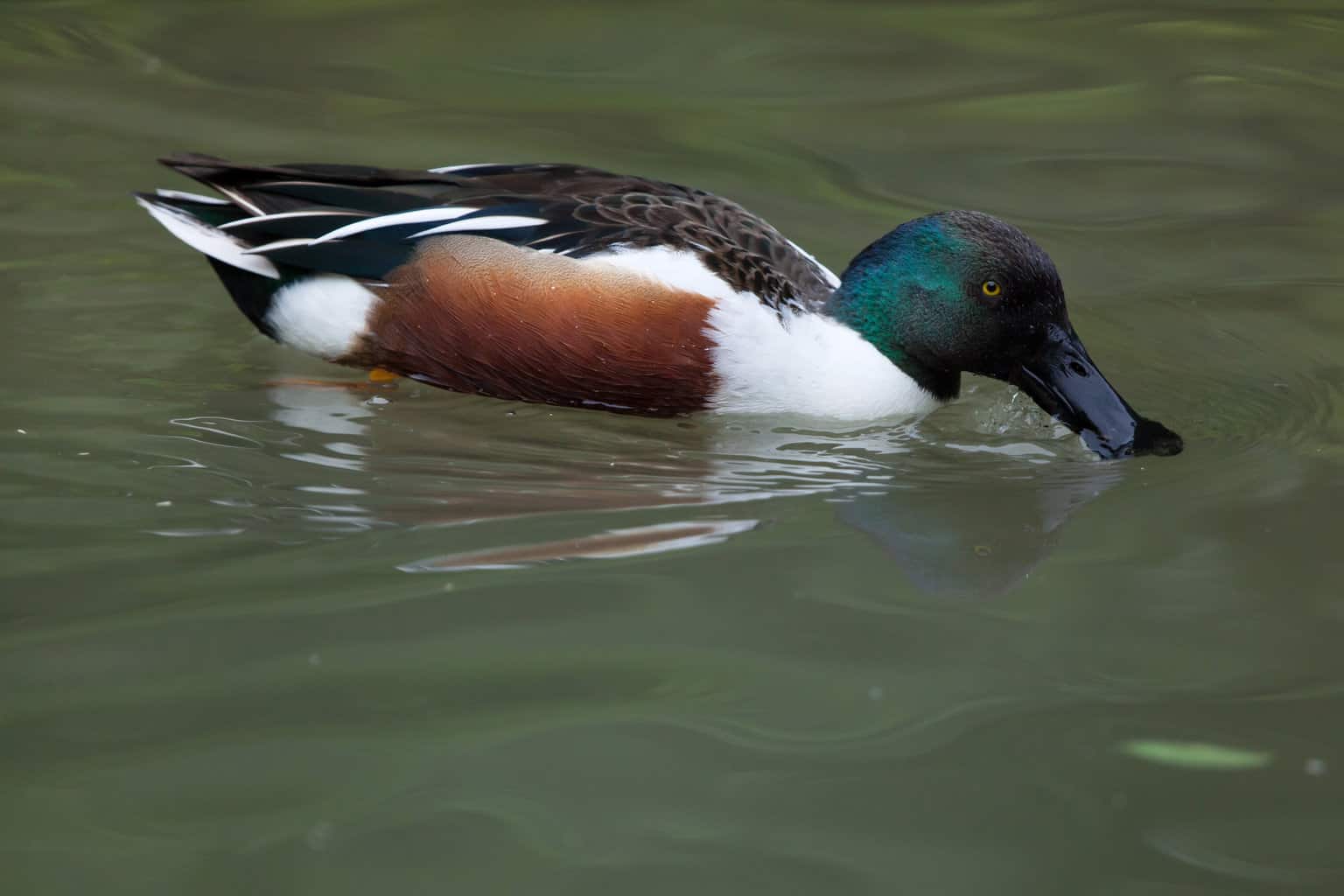
- Scientific Name: Spatula clypeata
- Length: 19 inches
- Weight: 1.3 pounds
- Wingspan: 30 inches
The Northern Shoveler’s name comes from its thick, shovel-shaped bill.
The male has a green speculum and a dark green head. He has metallic brown and light blue wings and a whitish-gray body. The female looks mostly the same, but look for that bright orange bill to differentiate her from the male’s black bill.
Northern Shovelers can be found in India, Europe, Africa, and North America. Their breeding territory includes northern Idaho, but they can be found year-round in the south of the state.
Regardless of where they live, Northern Shovelers have an effective – but gross! – strategy for protecting their nests.
When she is startled, the female Northern Shoveler will flee her nest, defecating all over the eggs. This creates quite a mess for predators. Hopefully, this deters them from stealing and eating the eggs!
Red-breasted Merganser (Diving Duck)
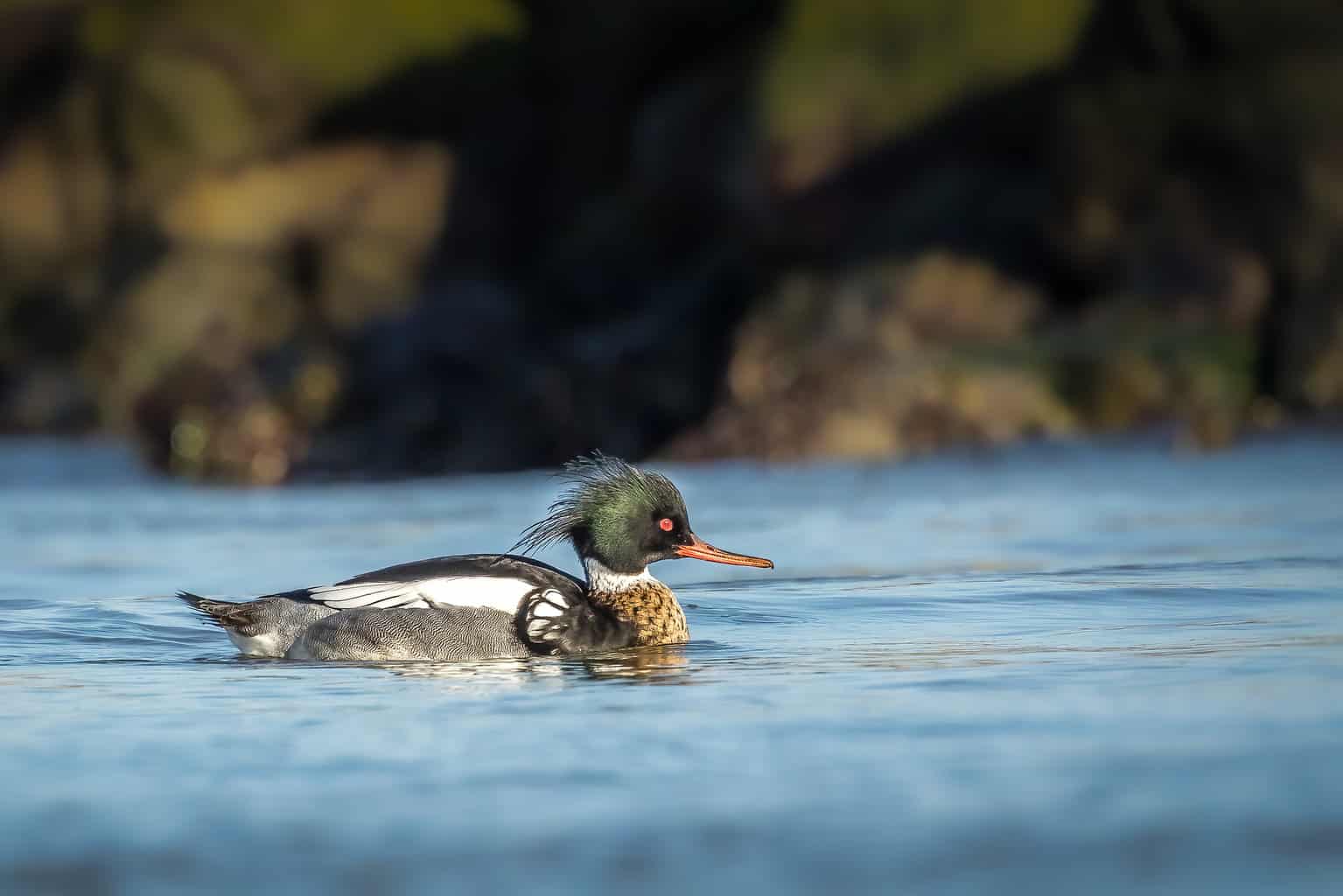
- Scientific Name: Mergus serrator
- Length: 20-24 inches
- Weight: 2.3 pounds
- Wingspan: 28-34 inches
Like other mergansers, the Red-Breasted Merganser has a shaggy crown that gives it a noteworthy silhouette.
The female’s head is reddish brown, and she has a plain gray body and an orange bill.
The male’s head is dark green (another one that gets described as black when identified from a distance), has a thick white ring around his neck, a cinnamon-colored chest, and a tri-colored body in black, gray, and white.
They don’t stay long in Idaho. Rather, they are simply migratory vagrants as they make their way to Canada in the spring and back to the west coast in the fall.
Red-Breasted Mergansers can take off and fly faster than most other ducks – they have been clocked flying up to 81 miles an hour!
Redhead Duck (Diving Duck)
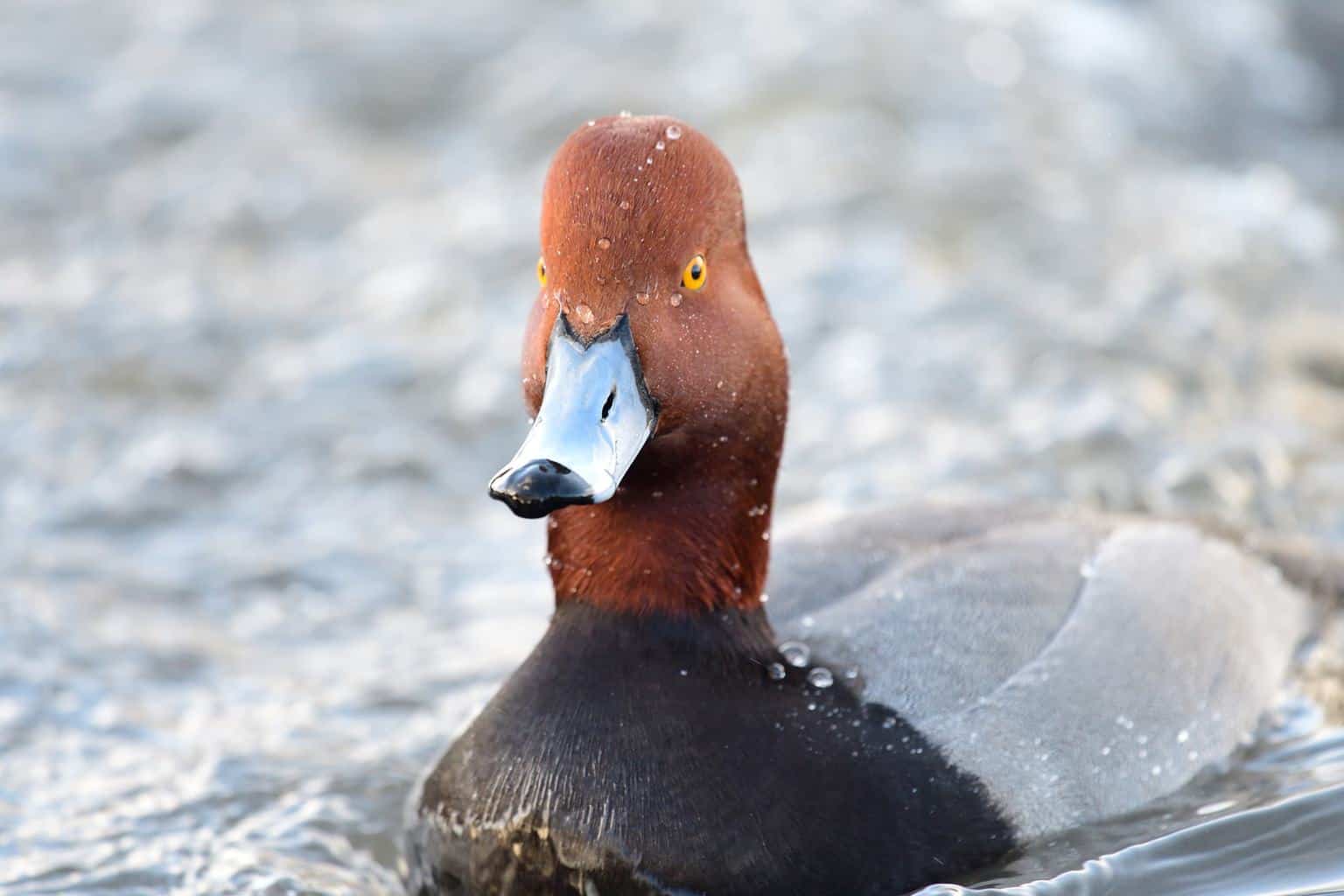
- Scientific Name: Aythya americana
- Length: 18-22 inches
- Weight: 2-2.5 pounds
- Wingspan: 33 inches
Redhead Ducks can be found year-round in northern and southern Idaho. They may be found in central Idaho, too, but only during their migration windows of spring and fall.
Males have a very dark, reddish-brown head and a black breast. Females are light brown and have minimal markings. All adults have rounded heads and gray flight feathers.
Redheads are prone to brood parasitism, meaning they lay their eggs in the nests of other ducks. Mostly, Redheads stick to the nests of other Redheads, but they will sometimes lay eggs in Canvasback nests.
Unfortunately, there is no guarantee of these eggs hatching. They may be rejected, or there may be too many for the “new” mother to hatch.
Ring-Necked Duck (Diving Duck)
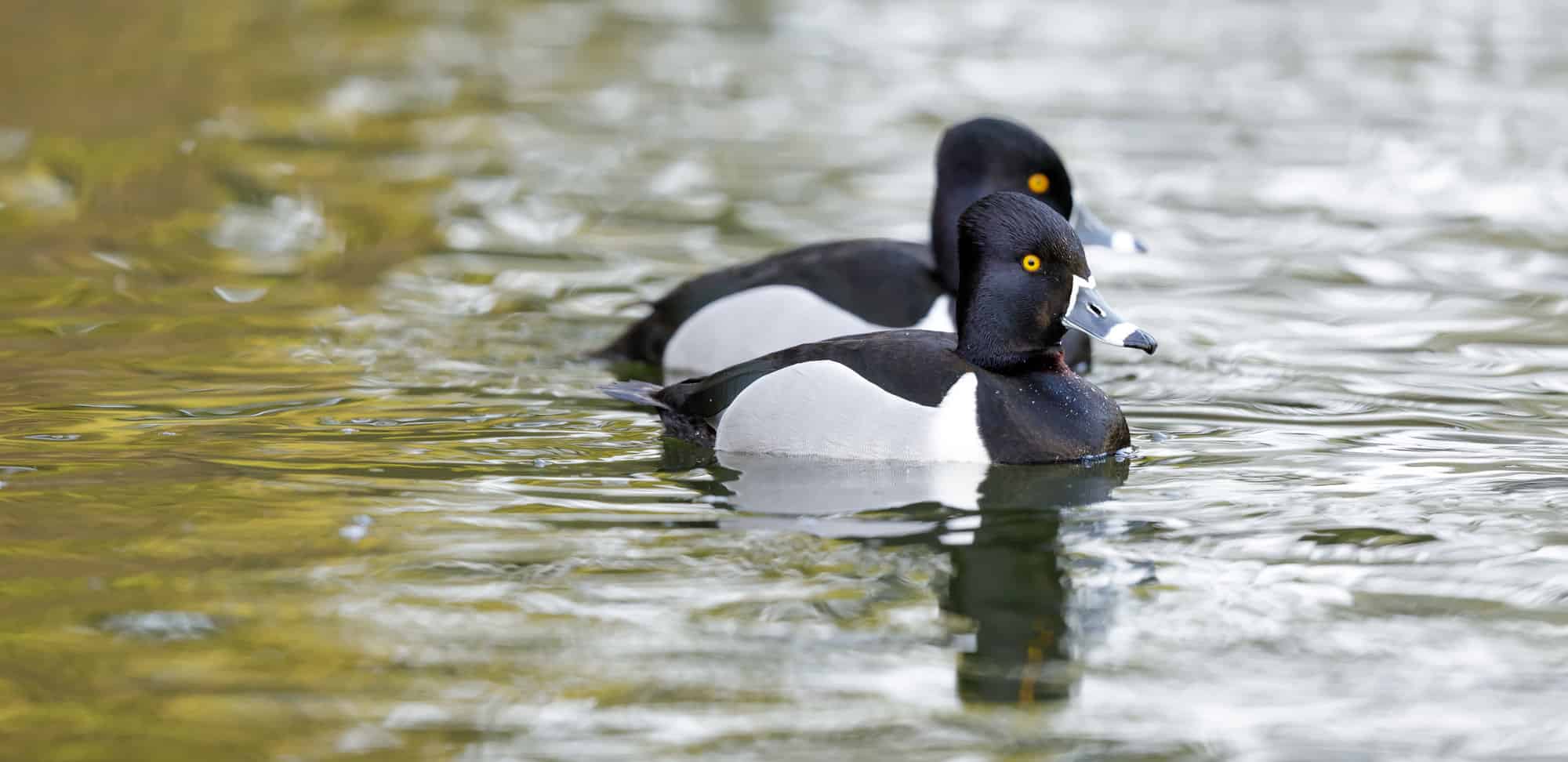
- Scientific Name: Aythya collaris
- Length: 15.3-18.1 inches
- Weight: 17.3-32.1 ounces
- Wingspan: 24.4-24.8 inches
In the 1800s, the naturalists who named the Ring-Necked Duck never actually saw a specimen when it was alive. When they examined the remains of the duck, they thought the copper ring around its neck was quite attention-grabbing.
And so they gave it what seemed like an obvious name. Unfortunately, that copper ring is nearly unnoticeable on a living, breathing Ring-Necked Duck!
Instead, the most noticeable ring on the Ring-Necked Duck is actually around its bill. Some have suggested the duck’s name should be changed to Ring-Billed.
Ring-Necked Ducks aren’t deep divers. They prefer to live in shallow waters like ponds and marshes. They live in Idaho year-round.
Ruddy Duck (Diving Duck)
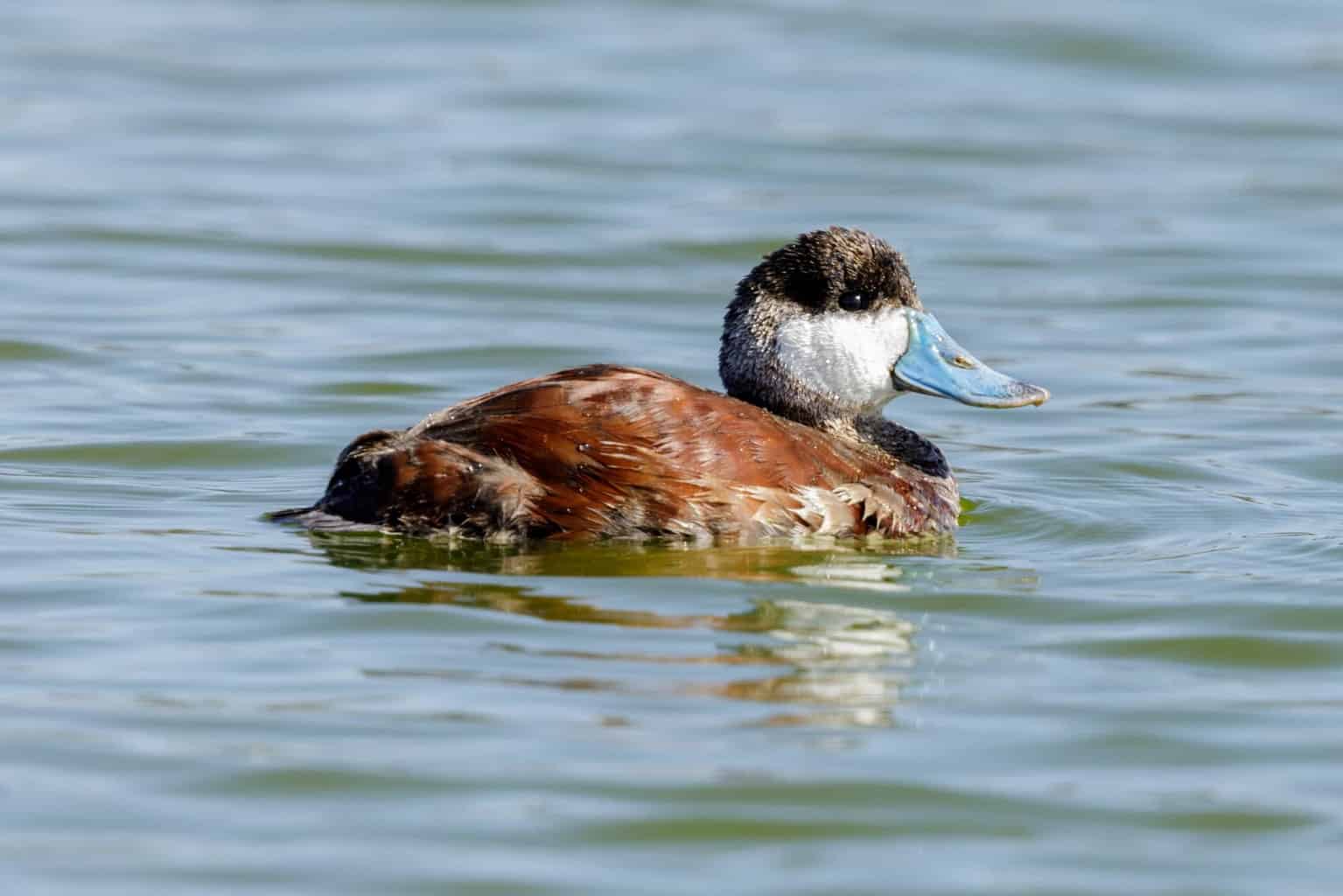
- Scientific Name: Oxyura jamaicensis
- Length: 13.5-17 inches
- Weight: 1.23 pounds
- Wingspan: 18.5 inches
The Ruddy Duck’s bright blue bill is only visible in the summertime. For the rest of the year, males and females alike have black bills.
Breeding males have long and pointed tails that they lose in the fall. His big white cheek patch sticks around all year. Females are brownish-gray.
Ruddy Ducks are some of the most aggressive duck species. Males will chase and attack other kinds of ducks, and they don’t like to share territory, even with other Ruddy Ducks. They will chase rabbits away from their nests, too.
Ruddy Ducks are one of Idaho’s year-round ducks, at least in the western half of the state.
Surf Scoter (Diving Duck)
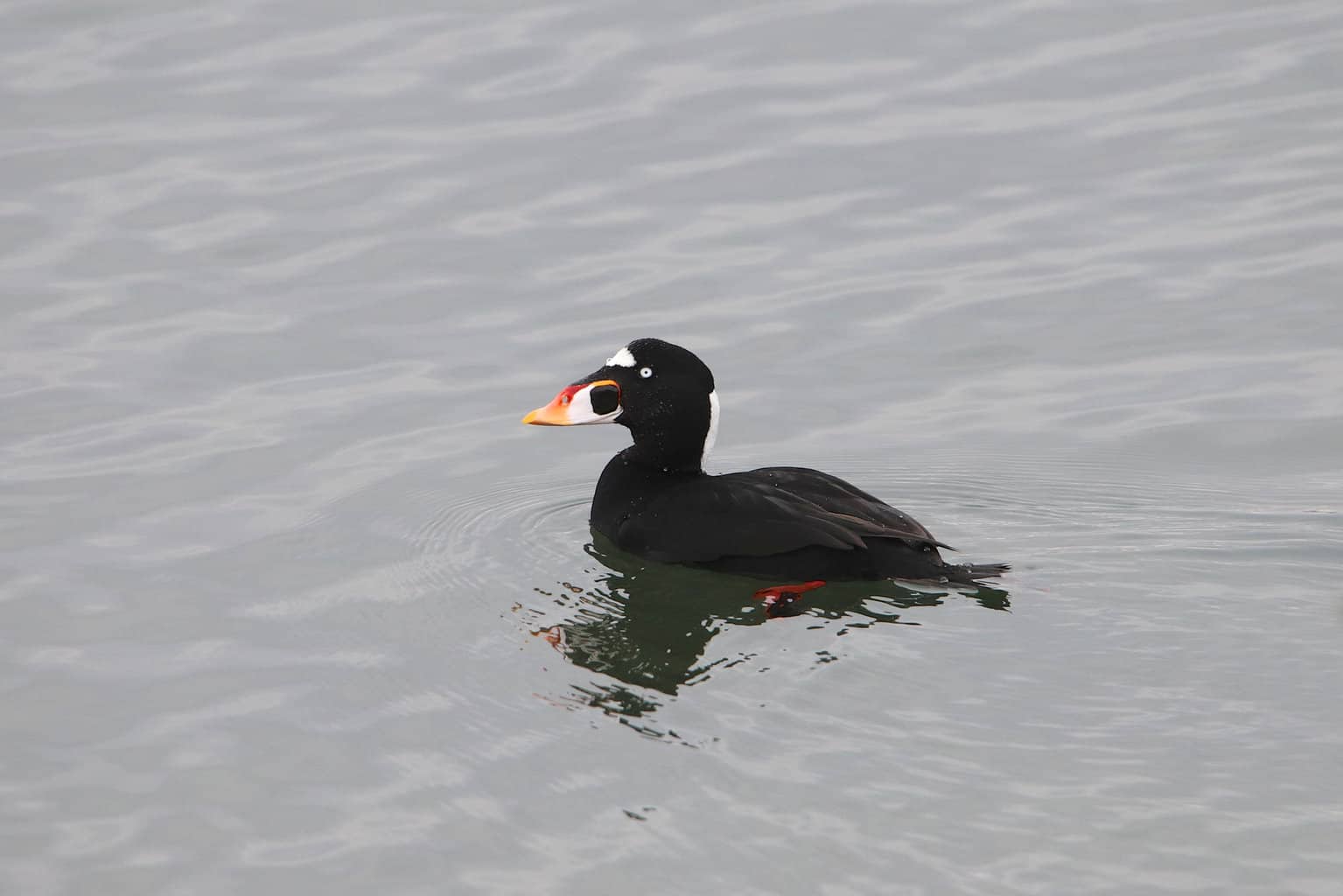
- Scientific name: Melanitta perspicillata
- Length: 18.9-23.6 inches
- Weight: 31.8-45.6 ounces
- Wingspan: 29.9-30.3 inches
Surf Scoters are considered accidental migrants to Idaho.
They have been observed in 12 Idaho counties, mostly in the panhandle.
Male Surf Scoters earned the nickname “old skunkhead,” thanks to the big black and white patches on his head. He also has an oversized orange, black, and white bill. Females are almost entirely brown, with few markings.
Their breeding territory is northern Canada and Alaska, where the boreal forest meets the tundra. They spend the winter along the North American coasts of both the Pacific Ocean and the Atlantic Ocean.
Tufted Duck (Diving Duck)
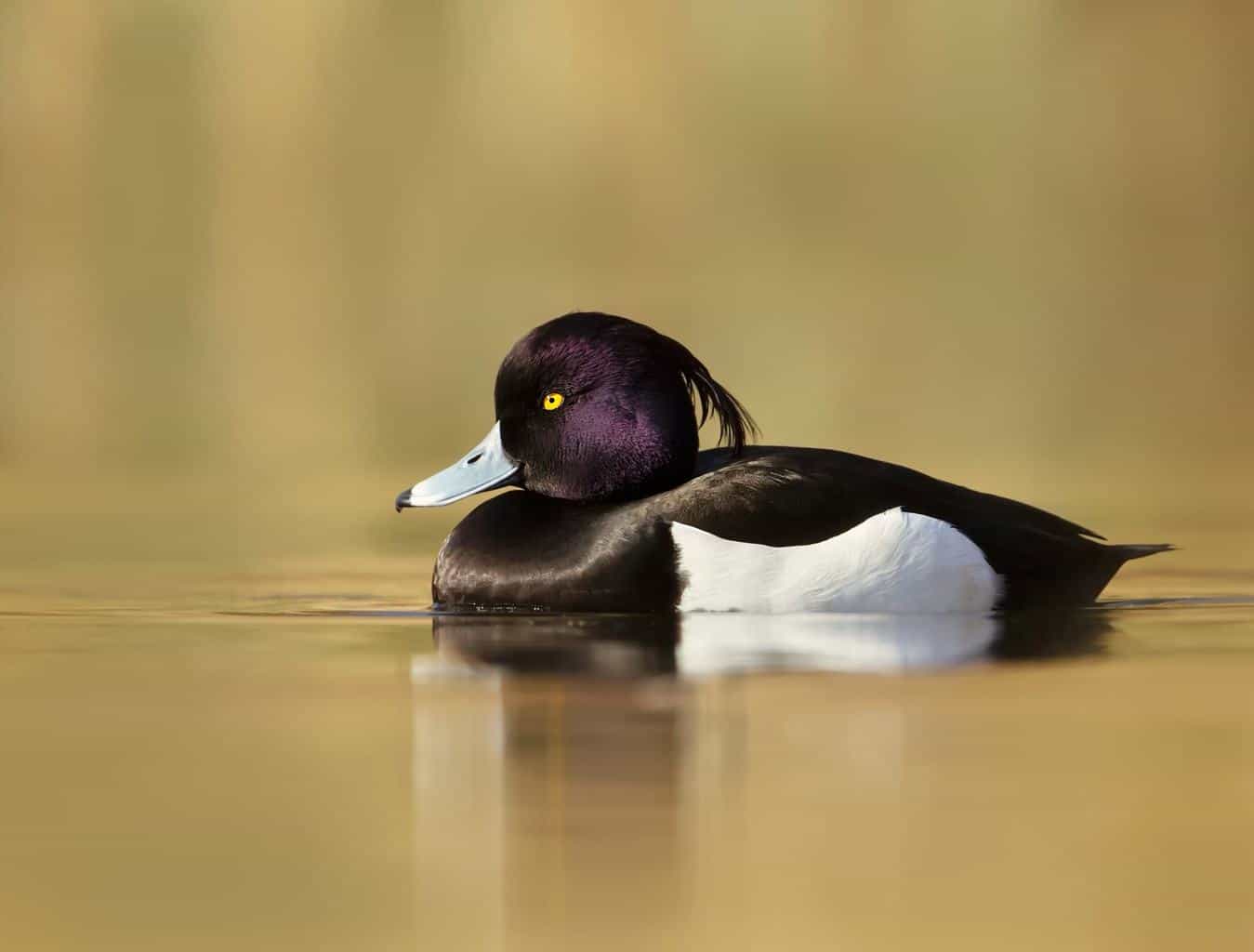
- Scientific name: Aythya fuligula
- Length: 15.7-17.7 inches
- Weight: 1.66-1.99 pounds
- Wingspan: 7.63-8.3 inches
The Tufted Duck is primarily a Eurasian duck, but some individuals do make their way into North America. They are considered rare throughout North America, except in western Alaska.
Males are almost entirely black, but they have white flanks. Their bill is grayish-blue, and their eyes are golden. They have a small, thin crest that runs along the back of the head. Females are brown, and they have a black tip at the end of their bill.
Idaho Fish and Game workers have confirmed sightings of Tufted Ducks in only three counties: Benewah, Gooding, and Kootenai.
Wood Duck (Dabbling Duck)
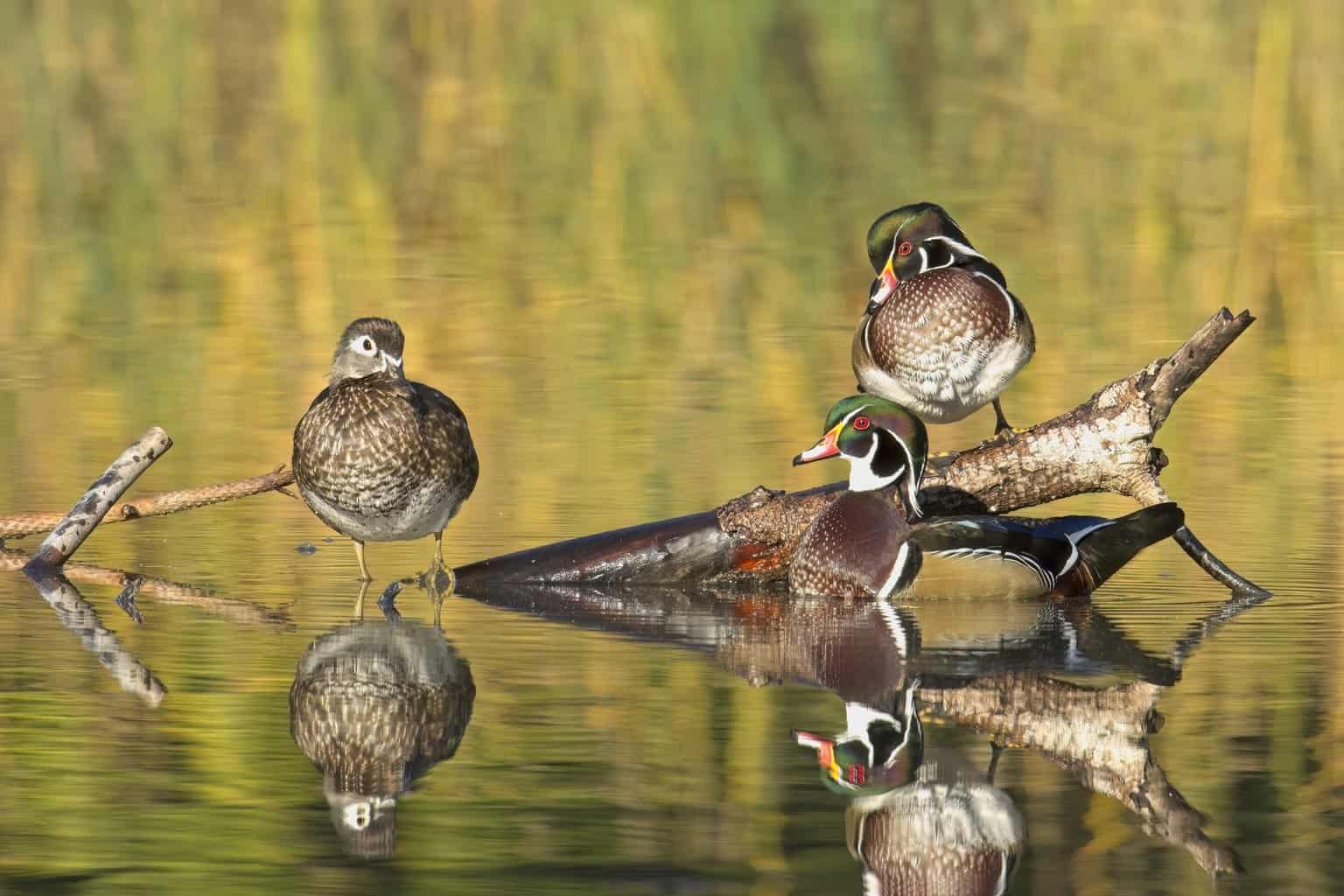
- Scientific Name: Aix sponsa
- Length: 17-20 inches
- Weight: 1.5 pounds
- Wingspan: 28 inches
Talk about an easily recognizable bird. The male Wood Duck has a dark, iridescent green head lined with white stripes and a reddish-brown breast with white mottling.
The female lacks the same dramatic patterns. She is grayish brown. During the fall, male Wood Ducks look pretty similar to females, but he keeps his multi-colored bill.
Wood Ducks nest in abandoned cavities from other birds and ducks, near wetlands, swamps, marshes, and shallow rivers. The easiest way to find them is to look for cattails along the water’s edge; Wood Ducks love cattails!
They are year-round residents of Idaho, so you may be able to find them in spring, summer, fall, and winter.
Final Thoughts
One of the reasons Idaho has so many ducks is that it sits right on the dividing line of many ducks’ winter and summer territories.
There are plenty of incredible birds to identify in Idaho, whether you are a resident or a visitor. Maybe things will change someday and when people think of Idaho, the first thing that comes to mind will be all of the birds and ducks that call Idaho home!

